Football Old
Football – Click on Inductee to view Biography
Create Group and ID
1980
- Sam Baker - Football
-
1980
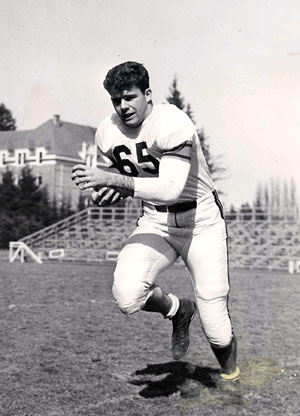 Sam Baker played his way into the state’s memory as a halfback at Oregon State and then place-kicker in the National Football League.
Sam Baker played his way into the state’s memory as a halfback at Oregon State and then place-kicker in the National Football League.Born in 1930, Baker grew up in Corvallis and had a standout athletic career at the school, helping the Spartans win the 1948 state championship in basketball.
Baker moved to Oregon State and played three seasons, 1950-52, for the varsity team as both a halfback and kicker. He graduated from the team as the record-holder in carries, 487, and yards gained, 1,947, and is credited with scoring the final touchdown at Bell Field in 1952.
The Los Angeles Rams drafted Baker in 1952, but he didn’t latch onto an NFL team until the next season with the Washington Redskins. In Washington, he carried the ball just 17 times and his career as a halfback ended. He revived his career as a kicker in 1956 and played 14 more seasons with the Redskins, Cleveland Browns, Dallas Cowboys and Philadelphia Eagles.
In 1956, he led the league with 17 field goals and made the first of his four appearances (56, 63, 64, 68) in the Pro Bowl. Baker led the league in numerous kicking categories throughout his career. In 1958, he averaged a league-best 45.4 yards per punt, made a league-best in PATs in both 1960 and ’62, and a league-best 18 of 25 field-goal attempts in 1966.
In his career, Baker made 179 of 316 field-goal attempts (56 percent) and averaged 42.6 yards on 703 punts. He missed just 16 attempts on 444 extra-points (96 percent). Baker was inducted to the Oregon Sports Hall of Fame as part of the inaugural class in 1980 and to the OSU Athletics Hall of Fame in 1991.
He died in 2007.
- Terry Baker - Football
-
1980
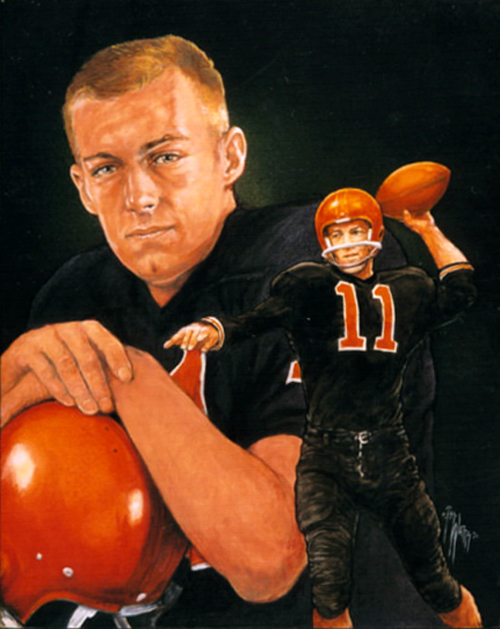 From the heart of Portland to the Willamette Valley and onto national success at the highest level, Terry Baker remains the state’s most decorated player for having won the Heisman Trophy while at Oregon State. And, he played basketball, too.
From the heart of Portland to the Willamette Valley and onto national success at the highest level, Terry Baker remains the state’s most decorated player for having won the Heisman Trophy while at Oregon State. And, he played basketball, too.Born in 1941 in Minnesota, Baker played football, basketball and baseball at Portland’s Jefferson High, and led the Democrats to an unprecedented level of athletic success. While at the school, the Demos won the state football title in 1958 and ’59 with the 6-foot-3 Baker at quarterback, the state baseball title in 1959 with Baker as the winning pitcher of the title game, and reached the state boys basketball tournament in 1959 and ’60 with Baker as point guard.
Despite the lack of success at the state level in basketball, Baker chose to attend OSU on a basketball scholarship to play for legendary coach Slats Gill. He quickly joined the football program to play under coach Tommy Prothro.
Baker guided the OSU football team as a dual-threat quarterback. In 1962, he passed for 1,738 yards and ran for 538 more. The team reached the Liberty Bowl and beat Villanova 6-0 thanks to a 99-yard touchdown run by Baker. He won the Heisman Trophy, was voted college player of the year by the Associate Press and Sporting News and was named Sportsman of the Year by Sports Illustrated, which described him as a “James Bond in shoulder pads.”
The Beavers were not in the running to reach the Rose Bowl as the Pacific Coast Conference had disbanded in 1959 and OSU, along with Oregon, wouldn’t join what immediately became known as the Pac-8 until 1964.
The OSU basketball team played its way into the 1963 Final Four behind a standout line-up that included Mel Counts and Jim Jarvis in addition to Baker.
The Los Angeles Rams made Baker the first pick of the 1963 National Football League draft, but he started just one game and scored just three touchdowns in three seasons. He played one season, 1966, for the Edmonton Eskimos of the Canadian Football League before retiring to become a lawyer.
Baker was inducted to the Oregon Sports Hall of Fame as part of the inaugural class in 1980. He has also been inducted to the Oregon State University Hall of Fame, College Football Hall of Fame as well as the National High School Athletics Hall of Fame. OSU has retired his jersey number, 11.
Baker lives in Portland.
- Steve Barnett - Football
-
1980
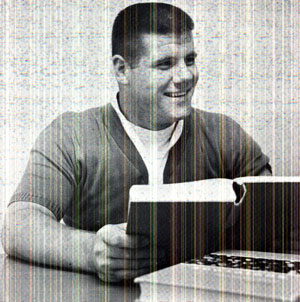 Steve Barnett played his way into the state’s memory as an All-American football player and student before a short career in the National Football League.
Steve Barnett played his way into the state’s memory as an All-American football player and student before a short career in the National Football League.Born in 1941, Barnett grew up in Oklahoma before moving to the University of Oregon in 1960 as a 6-foot-2 lineman on both offense and defense. At Oregon, he was voted All-Conference three times, including 1960 when he started on the squad that played in the Liberty Bowl.
In 1962, he was voted as a First-Team All-American at offensive tackle and as an academic First Team All-American. He played in the East-West Shrine Game as well as the Hula Bowl.
In 1963, the Chicago Bears selected Barnett in the second round of the NFL Draft, while the San Diego Chargers selected him in the ninth round of the AFL Draft. He chose the Bears and played one season in Chicago and one with the Washington Redskins.
Barnett was inducted into the Oregon Sports Hall of Fame in 1980 as part of the inaugural class and into the University of Oregon Sports Hall of Fame in 2000.
- John Beckett - Football
-
1980
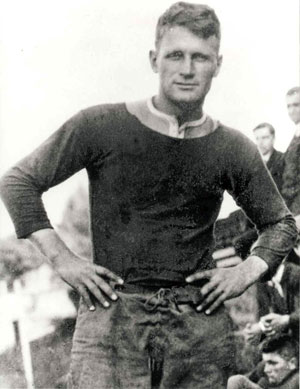 Beckett died at age 89 in 1981, a year after being inducted into the Oregon Sports Hall of Fame as part of the inaugural class. He was inducted into the College Football Hall of Fame in 1972 and the University of Oregon Sports Hall of Fame in 1992.
Beckett died at age 89 in 1981, a year after being inducted into the Oregon Sports Hall of Fame as part of the inaugural class. He was inducted into the College Football Hall of Fame in 1972 and the University of Oregon Sports Hall of Fame in 1992.John "Jack" Beckett (January 5, 1892 – July 26, 1981) was an American football offensive tackle who played for the University of Oregon and Mare Island. Born in rural northeastern Oregon, Beckett attended Eugene High School in Eugene before enrolling at the University of Oregon.
University of Oregon
Although primarily used as an offensive tackle, Beckett excelled at several positions, occasionally playing halfback and punter. Beckett was the team captain in his senior year of 1916 and was named to the all-Pacific Coast Conference team. He led the team to an undefeated record and tie for the conference championship with the University of Washington. Oregon was chosen to represent the conference in the 1917 Rose Bowl where they defeated Pennsylvania 14-0, with Beckett named the game's most valuable player.
U.S. Marine Corps service
With the United States' entry in World War I, Beckett joined the Marines in his senior year, and was assigned to the Marine base at Mare Island, California. He joined the Mare Island football team, coached by Beckett's Oregon coach Hugo Bezdek, and was selected as team captain. With the U.S. at war, the 1918 Rose Bowl featured two service teams: Beckett's Mare Island team and the U.S. Army's Camp Lewis team, with Mare Island winning 19-7. Beckett is the only person to have been the captain of two different Rose Bowl teams.
Beckett served 50 years in the Marines, coaching Marine teams at Mare Island, Quantico, and San Diego, amassing an overall coaching record of 56-19-3. He achieved a final the rank of brigadier general.
Legacy
Beckett was named to the College Football Hall of Fame in 1972, and was a charter member of both the University of Oregon Athletic Hall of Fame in 1992, and the Oregon Sports Hall of Fame in 1980. He died in La Jolla, California in 1981.
- Jules "Zuck" Carlson - Football
-
1980
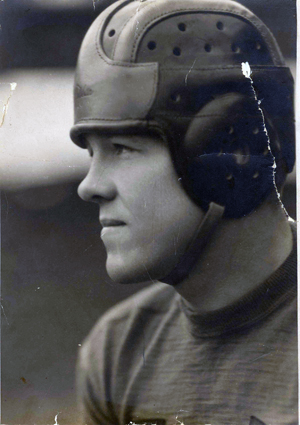 Jules Carlson played his way through The Dalles and Oregon State into a professional career in the early days of the Chicago Bears.
Jules Carlson played his way through The Dalles and Oregon State into a professional career in the early days of the Chicago Bears.
Born in 1904, Carlson grew up in The Dalles and played center and guard at Oregon State from 1926-28. The Beavers were 16-6-1 in those seasons, including 7-1 in 1926. He signed with the Bears in 1929 after receiving a contract for $100 per game plus food, and a one-way ticket to Chicago in order to sign the contract.He played under Coach George Halas into 1936. The Bears won two NFL titles, including the first championship game, a 23-21 victory over the New York Giants in 1933. Carlson opened running lanes for backs Red Grange and Bronco Nagurski. He also played in the first "College All-Star Game," in which college players played the NFL champion.
Following his career, he remained in Chicago and worked as a pipefitter.
Carlson was inducted to the Oregon Sports Hall of Fame as part of the inaugural class in 1980, and the Oregon State Athletics Hall of Fame in 1994.
- Chas "Shy" Huntington - Football
-
1980
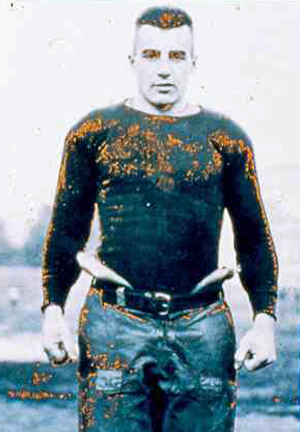 Charles "Shy" Huntington left an indelible mark on the University of Oregon football program by leading it to the 1917 Rose Bowl as a player, then guiding the program to the 1920 Rose Bowl as head coach.
Charles "Shy" Huntington left an indelible mark on the University of Oregon football program by leading it to the 1917 Rose Bowl as a player, then guiding the program to the 1920 Rose Bowl as head coach.
Born in 1891, Huntington played three seasons for Oregon, beginning at age 23 in 1914.
Oregon reached the 1917 Rose Bowl with a 6-0-1 record, having beaten the Multnomah Amateur Athletic Club twice and given up just 14 points all season. The Ducks tied Washington 0-0, but beat Cal and the Oregon Agricultural College (OSU) to tie for the top spot in the newly formed Pacific Coast Conference.In the Rose Bowl, being played for only the third time as the "East-West Game," they faced Eastern power Pennsylvania, which was a heavy favorite despite being the third choice among Eastern teams after Harvard and Yale refused to travel by train to Pasadena.
Huntington played a key role in the game by intercepting three passes, throwing for a touchdown, rushing 17 times for 69 yards and a touchdown and kicking two extra points.
Oregon, coached by legendary Hugo Bezdek, won 14-0 before a crowd of 27,000.
Huntington was named All-American following the season.
In 1920, Huntington, who became coach in 1918, guided the Ducks to a 5-1 record, first place in the PCC and back to the Rose Bowl, where they faced unbeaten Harvard. Despite a standout performance from younger brother Hollis Huntington, who had 122 yards on 29 carries, the Ducks lost 7-6 before a crowd of 35,000. Oregon, which played its home games in newly christened Hayward Field, used just 13 players in the game.
Shy Huntington led the Ducks to a 26-12-6 record in his six seasons as coach. He also coached the basketball team for two seasons and the baseball team for one season.
He later coached Eugene High School for two seasons.
Shy Huntington was inducted to the Oregon Sports Hall of Fame as part of the inaugural class in 1980 and into the University of Oregon Athletics Hall of Fame in 1993.
- George Christensen - Football
-
1980
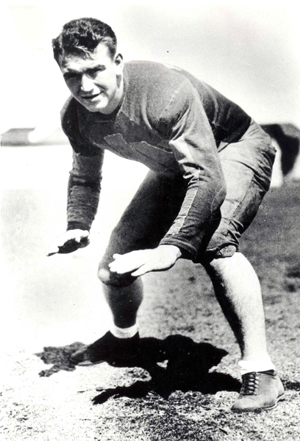 George Christensen carried the University of Oregon's name into the National Football League during the early years of the league as a lineman before becoming a successful businessman.
George Christensen carried the University of Oregon's name into the National Football League during the early years of the league as a lineman before becoming a successful businessman.
Born in Pendleton in 1909, Christensen played at Oregon from 1928-30 and was a Pacific Coast Conference all-star as a tackle in 1930. While at Oregon, the Ducks were a combined 23-7. Christensen often played entire games as both an offensive and defensive lineman.
After graduation, he moved to the NFL, which had begun in 1920. Christensen played three seasons for the Portsmouth Spartans, and five for the Detroit Lions, who won the league title in 1935. He played 93 games in eight seasons.
Three decades later, the Associated Press named him a lineman on the NFL’s All-1930s team.
In 1944, Christensen became a business owner with a former teammate manufacturing diamond core bits for the mining industry.
Christensen was inducted to the Oregon Sports Hall of Fame as part of its inaugural class in 1980 and the University of Oregon Athletics Hall of Fame in 1996.
- Norman "Red" Franklin - Football
-
1980
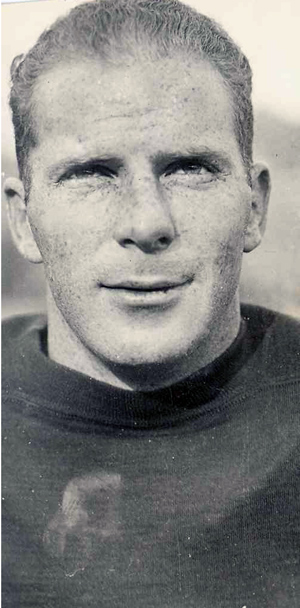 Norman ‘Red’ Franklin was an All-American at Oregon State, who played three seasons in the NFL before retiring.
Norman ‘Red’ Franklin was an All-American at Oregon State, who played three seasons in the NFL before retiring.Born in Rhode Island in 1911, he found his way to Corvallis and played running back from 1932-34. In 1933, Franklin had 94-yard kickoff returns in two games and was named an All-American. The Beavers were a combined 13-14-4 in his three seasons.
In the NFL, Franklin, who stood 5-foot-10, started nine games at tailback for the Brooklyn Dodgers in 1935, and played in three more games for the team the next two years, retiring with 366 yards and four touchdowns on 119 carries.
Franklin was inducted into the State of Oregon Sports Hall of Fame in 1980, and the Oregon State Athletics Hall of Fame in 1991.
- Bobby Grayson - Football
-
1980
 During his high school and college football days, Bobby Grayson became one of the West Coast’s greatest players, helping create a dynasty at both Jefferson High and then playing a key role in three teams that reached the Rose Bowl while at Stanford University.
During his high school and college football days, Bobby Grayson became one of the West Coast’s greatest players, helping create a dynasty at both Jefferson High and then playing a key role in three teams that reached the Rose Bowl while at Stanford University.Born in Portland in 1914, Grayson reached the Jefferson varsity as a freshman in 1928 in the first season of legendary coach Eric Waldorf’s career at the school. As a quarterback, halfback and defensive back, Grayson helped the Democrats improve from 3-5-1 to 10-0-0 in four seasons. The 1931 team is famed for having outscored opponents 287-6, including 169-0 in seven games against Portland Interscholastic League teams. Grayson scored 117 points in those seven games.
Grayson also starred on the Jefferson track and field team, winning state titles in the 100-yard dash and 220-yard low hurdles in both 1931 and ’32.
Stanford’s legendary football coach Glenn “Pop” Warner then recruited Grayson to Stanford before leaving the following season for the position at Temple University. At Stanford, Grayson starred on both offense, as a quarterback and fullback, and defense as a safety.
The Indians, as they were then known, won the Pacific Coast Conference title in 1933, ’34 and ’35, and played in the Rose Bowl at the close of each of those seasons. They won the 1936 Rose Bowl, 7-0, over Columbia.
Grayson earned a spot on the All-America team as a quarterback in 1934, and fullback in 1935. In ’34, he set a school record with four interceptions during a game against Washington. In his three seasons on the varsity team, Grayson ran for 1,547 yards on 405 carries. He is regularly listed among the top five players in the history of Stanford football.
Following his senior season, the Pittsburgh Pirates (Steelers) of the fledgling National Football League selected Grayson with the third pick of the third round of the league’s first draft. But Grayson - as did first overall pick Jay Berwanger of Chicago University - chose to go into private business. He worked for companies in Oregon and Washington and served as the head of the U.S. Savings Bond Division for Oregon for eight years until retiring in 1980.
During World War II, Grayson served as commanding officer of the USS Loyalty, a minesweeper.
Grayson passed away in 1981 at age 66. He was inducted to the College Football Hall of Fame in 1955, and into the Oregon Sports Hall of Fame as part of the initial class in 1980.
- Vic Sears - Football
-
1980
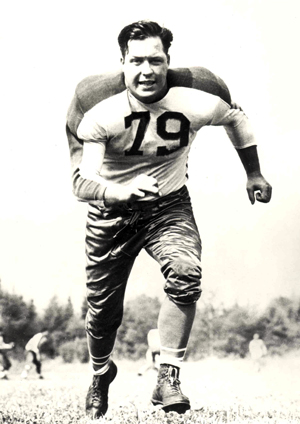 Vic Sears played his way from Central Oregon, through Corvallis and into a spot in state sports lore as a durable lineman on Oregon State’s first bowl team.
Vic Sears played his way from Central Oregon, through Corvallis and into a spot in state sports lore as a durable lineman on Oregon State’s first bowl team.Born in Ashwood in 1918, Sears found his way to Oregon State and played there for three varsity seasons (1938-40) as a 6-foot-3, 200-pound tackle on the offensive line. As a junior, Sears teamed with center Quentin Greenough and guard Len Younce to lead the Beavers to a 9-1-1 record and win over Hawaii in the 1940 Pineapple Bowl, played in Honolulu. Following his senior season, he was voted first-team All-America. He played in the East-West Shrine Game in 1941.
The Pittsburgh Steelers selected Sears in the fifth round of the 1941 Draft, but he signed with the Philadelphia Eagles and played there through the 1953 season, missing 1944 due to a broken leg. He helped the Eagles win the NFL title in 1948 and ’49.
In 1943, Sears played for the legendary “Steagles,” the team formed by the merger of the Eagles and Steelers due to the shortage of players caused by World Ward II. In 1950, Sears became a defensive lineman as well and played there exclusively his final two seasons.
In 12 seasons, he played 131 games, earned All-NFL recognition on either the first of second team five times and earned the nickname “Old Smoothie.” He was voted to the NFL’s Team of the Decade for the 1940s at tackle.
Sears was inducted to the Oregon Sports Hall of Fame as part of the inaugural class in 1980 and into the Oregon State Athletics Hall of Fame in 1991.
- Norm Van Brocklin - Football
-
1980
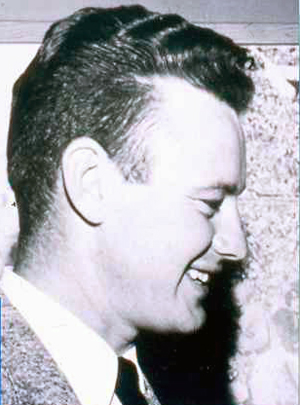 Norm Van Brocklin established the tradition of quarterback excellence at the University of Oregon, won two championships in the National Football League and coached for 13 seasons in the NFL before the age of 50.
Norm Van Brocklin established the tradition of quarterback excellence at the University of Oregon, won two championships in the National Football League and coached for 13 seasons in the NFL before the age of 50.Van Brocklin was born in 1926 in South Dakota, but grew up in California and joined the Navy in 1943. He played at Oregon from 1946-48 and led the team to a 16-5 record as starting quarterback during his sophomore and junior seasons. He also served as punter. In 1948, under second year coach Jim Aiken, Oregon went 7-0 and tied California, which went 6-0, for the Pacific Coast Conference title, but missed a trip to the Rose Bowl when the Bears won a vote by other conference members. Oregon played in the Cotton Bowl, but lost to Southern Methodist 21-13.
Van Brocklin threw for 1,949 yards and 18 touchdowns in his two years as Oregon quarterback, and was named All-American after the 1948 season. He left school after his junior season and was drafted by the Los Angeles Rams in the fourth round in 1949.
Van Brocklin platooned with established quarterback Bob Waterfield in 1950 and the team established a scoring record by averaging 38.8 points per game. Van Brocklin led the league in passer rating, but the Rams lost to Cleveland in the NFL title game.
In ’51, the Rams again reached the title game and beat Cleveland 24-17. During the season, Van Brocklin threw for 554 yards in a game to set an NFL record.
The Rams also reached the league title game in 1955, where they lost to the Browns 38-14.
Van Brocklin played nine seasons with the Rams before moving to Philadelphia, where he led the Eagles to the NFL title in 1960. Van Brocklin was voted league MVP and named All-Pro in 1960. In his 12 seasons, he passed for 23,611 yards, 178 touchdowns and was selected to the Pro Bowl nine times. He led the league in punting average once.
Directly after the 1960 season, Van Brocklin, at age 34, retired and became the head coach of the expansion Minnesota Vikings. He compiled a record of 29-5-14 in six seasons, before leaving to be an NFL commentator for CBS in 1967. The following season he became head coach of the Atlanta Falcons. In seven seasons with the Falcons, he finished 37-43-3 and had the team within reach of the playoffs before being fired in 1974.
Following his coaching career, he became a pecan farmer. He died in 1983.
Van Brocklin was inducted to the Oregon Sports Hall of Fame as part of the inaugural class in 1980, and the University of Oregon Sports Hall of Fame in 1993. He was enshrined in the Pro Football Hall of Fame in 1971.
- Len Younce - Football
-
1980
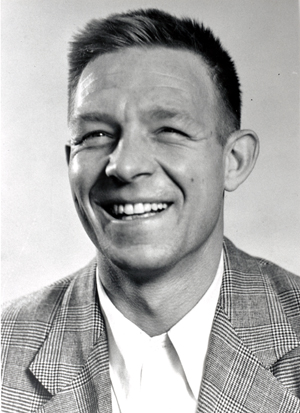 Len Younce earned his spot in the state’s sports memory as a scrappy lineman who helped Oregon State to its first bowl game and then reached the NFL.
Len Younce earned his spot in the state’s sports memory as a scrappy lineman who helped Oregon State to its first bowl game and then reached the NFL.Born in Dayton in 1917, Sears graduated from Portland’s Roosevelt High and enrolled at Oregon State, where he played three varsity seasons (1938-40) as a 6-foot-1, 200-pound guard on the offensive line. As a junior, Younce teamed with center Quentin Greenough and tackle Vic Sears to lead the Beavers to a 9-1-1 record and win over Hawaii in the 1940 Pineapple Bowl, played in Honolulu. Following that season, he was voted honorable mention All-America.
The New York Giants selected Younce in the eighth round of the 1941 Draft and he played there on the offensive line for six seasons, helping the team reach the NFL title game three times. He also played linebacker, and handled punting and placekicking duties at times.
In 1944, he led the league in punting yards. In 1948, he made 36 of 37 extra-point attempts. He finished his career with 10 interceptions.
Younce was voted All-NFL five times, and was voted to the NFL’s Team of the Decade for the 1940s at guard.
Following his playing career, Younce returned to Oregon State as an assistant coach for six seasons. He also coached in the Canadian Football League for the Edmonton Eskimos.
In 1992, Younce coached Joseph High in Eastern Oregon for one season at age 75.
Younce was inducted to the Oregon Sports Hall of Fame as part of the inaugural class in 1980 and into the Oregon State Athletics Hall of Fame as part of its inaugural class in 1991.
- John Kitzmiller - Football
-
1980
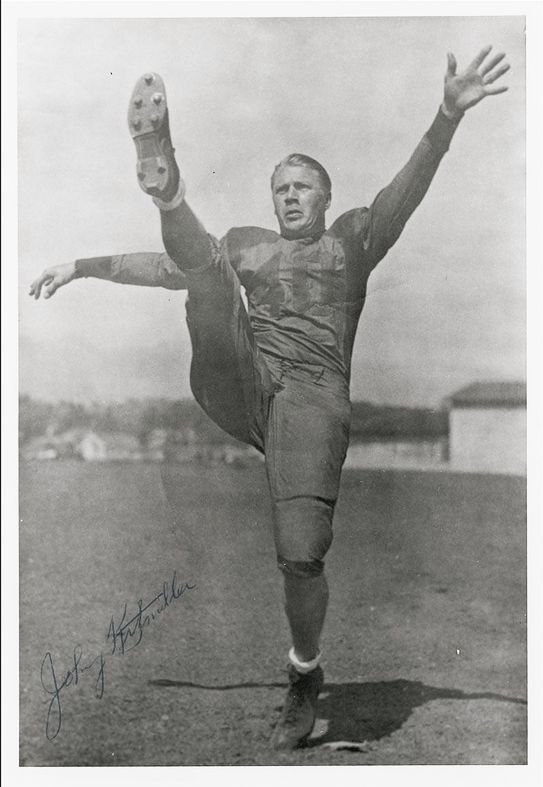
Pennsylvanian, John Kitzmiller had his heart set on a football career at West Point and was particularly impressed with Army coach John McEwan. Just when Kitzmiller was about to enter West Point, McEwan was lured to the head coaching position at Oregon. Without hesitation, Kitzmiller followed him and the two brought the Ducks into national prominence. McEwan and Kitzmiller shared a warm sense of humor, which bonded the two, and together they led the Ducks to national prominence. Kitzmiller was given the nickname the “Flying Dutchman” for his spectacular tackles for his size at 165lb and 6ft. The Dutchman scored 14 touchdowns over his college career. While on line, 1928-1930, the Ducks had a 23-7 record, two of the games were lost because Kitzmeller had a broken foot. He was awarded the 2 time All-Pacific Coast Conference defensive back and offensive back. During his senior year he earned the 2nd-team All-American honors.
After U of O, Kitzmiller played one season as fullback in 1931 with the NY Giants. He returned to University of Oregon as an assistant football coach from 1932-1935. When WWII rolled around, Kitmiller served a tour in India as a captain in the U.S. Army Air Force and returned to Oregon again to establish his own manufacturing company in the Williamette valley. He was elected to the College Football Hall of Fame in 1969 the University of Oregon Athletic Hall of Fame in 1992, and the Oregon Sports Hall of Fame in 1980. Kitzmiller died in Oregon in 1986.
- Jake Leicht - Football
-
1980
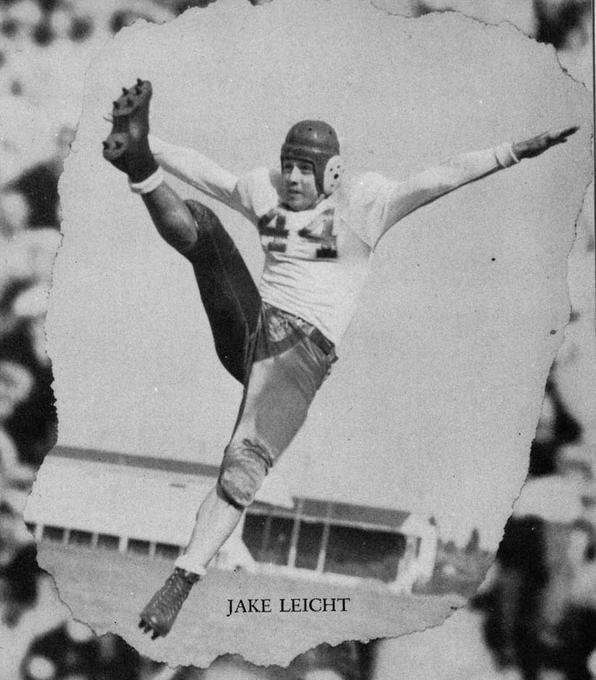
Jake Leicht is one of the football program’s stars of the 1940s, who didn’t start his career in Eugene until age 26.
Born in North Dakota in 1919, Leicht reached the Ducks in 1945 as a 60-minute player, starring as a halfback, kick returner and defensive back.In his first year, he was named All-American after posting 10 interceptions, including three in a game against California and three in a game against Washington State. He also led the team in rushing with 411 yards, passing with 376 yards and punt return yards with 322 on a 3-6 team. The Washington Redskins drafted him in the eighth round in 1946, but he returned to play two more years for the Ducks.
In his third season, Leicht led the Pacific Coast Conference in rushing with 630 yards, scoring with 56 points as the team went 7-3 with Norm Van Brocklin at quarterback. He finished his career with 1,253 rushing yards, and is still fourth on the all-time team list with 980 punt return yards. He’s still second on the all-time list for interceptions with 17.
Leicht then moved to the Baltimore Colts of the All-America Football Conference.
His pro career spanned 26 games in which he had 26 carries and 13 receptions.
- Mike Mikulak - Football
-
1980
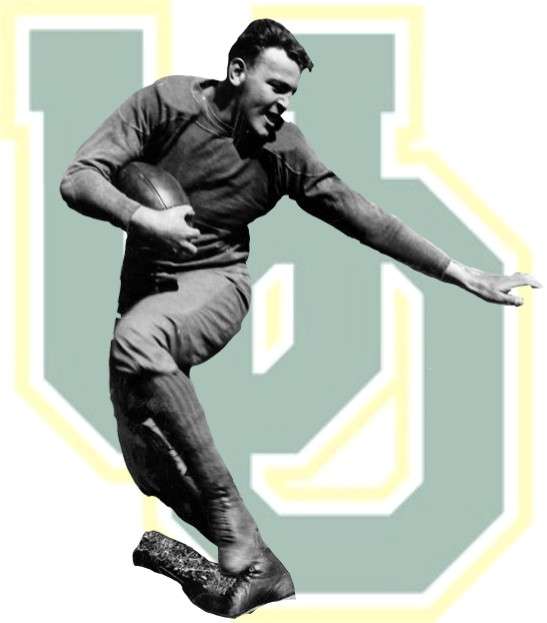
“Iron Mike” played only three seasons for the University of Oregon football team, but left a lasting impression enough to warrant Hall of Fame status.
Mikulak grew up in Minnesota, and moved to Eugene to play for the Ducks in 1931-33. He started at fullback in ‘32 and ‘33 and was an First Team All-America pick in ‘33 when the Ducks tied for the Pacific Coast Conference title with a 9-1 overall record and 4-1 conference record.The next fall, Mikulak, who stood 6-foot, joined the Chicago Cardinals of the NFL and played three seasons, helping the team to a winning record (6-4-2) in 1935. He was named second-team All-Pro that season.
After three years, he returned to Eugene as an assistant coach for four seasons and completed his degree. He joined the Armed Forces in 1941 and served in the military for nearly three decades.
He earned his nickname for wearing an aluminum plate to protect a protruding sternum.
- George Shaw - Football
-
1980
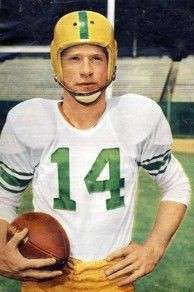
George Shaw reached the heights of high school, college and pro football at a time when the pro game was quickly developing in the national spotlight.
Shaw quarterbacked Grant High to state titles in 1949 and ‘50 - each season ending with an unbeaten record, then headed to Eugene and the University of Oregon.
At Oregon, Shaw was a standout at quarterback and as a defensive back, regularly playing all 60 minutes. He led the Pacific Coast Conference in interceptions with 13 as a freshman in 1951. As a senior he led the nation in total yards offense with 1,536 and was named All-America. His career closed with 3,508 yards and 26 touchdowns rushing and passing as well as 18 interceptions on defense - a career mark that still stands.Shaw also earned All-American status as part of the baseball team and had an offer to play for the New York Yankees.
In 1955, the Baltimore Colts selected Shaw with the first pick of the NFL Draft and he quickly moved into the starting role, until the 1956 season when an injury allowed Johnny Unitas to move into the starting role. After three seasons in Baltimore, Shaw moved to New York and played two seasons for the Giants. He also played a season with the Minnesota Vikings, where he was replaced by Fran Tarkenton, and one for the Denver Broncos of the AFL. He threw for 5,829 yards and 41 touchdowns in his combined NFL and AFL career.
The University of Oregon inducted him into its Hall of Fame in 1992, and he is a member of the Portland Interscholastic League Hall of Fame as well.
- Bill Steers - Football
-
1980
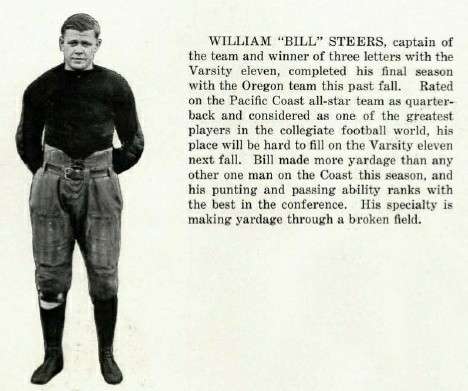
“Big Bill” Steers made a name for himself at the University of Oregon as an all-around player and member of the 1920 Rose Bowl squad, and later earned national respect as a coach, educator and administrator.
Born in 1897, Steers grew up in The Dalles and reached the football program in Eugene in 1917. In 1919, after serving in the Marines during the 1918 season, Steers helped the Ducks win the Pacific Coast Conference title with a 5-2 record - earning a spot in the 1920 Rose Bowl. Oregon lost 7-6 to Harvard, but Steers scored the Ducks’ points on a pair of drop kicks. Legendary coach George Halas was named the game MVP for Harvard.In 1920 he served as the team captain for a 3-2-1 squad. Steers earned All-PCC First-Team honors in three seasons, twice as a quarterback (1917 and ‘19), and as a guard in 1920.
After graduating, Steers played for the Multnomah Amateur Athletic Club team before attaining a Master’s degree from Columbia in 1928. He coached the football team at Cal University - Pittsburgh from 1929-37 before returning to Columbia to earn a doctorate in physical education.
He served in the Navy in 1943-45, and led the project to build a recreation facility at Admiralty Island in the South Pacific.
Steers was head of the Physical Education program at Miami University in Florida prior to his passing at age 60.
1981
- Ross Carter - Football
-
1981
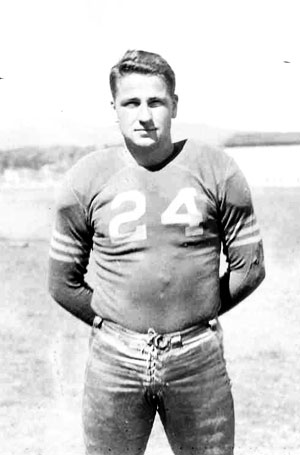 Ross Carter earned a reputation as a fearsome lineman and masters athlete and was eventually voted into an athletic hall of fame four times.
Ross Carter earned a reputation as a fearsome lineman and masters athlete and was eventually voted into an athletic hall of fame four times.Born in Missouri in 1914, he grew up in Oregon and graduated from Lakeview High School. He attended Southern Oregon University and played football in 1932 and ‘33 under coach Howard Hobson before transferring to Oregon in 1934.
Carter filled out to 6-foot, 238 pounds and played on both offense and defense as a guard for the Ducks in 1934 and ’35.
Carter was the first Oregon player selected in the NFL Draft, taken in the eighth round of the inaugural event by the Chicago Cardinals in 1936.
He played four seasons as a reserve for the Cardinals, then moved into the lumber business as co-owner of Starr-Carter.
His son, Ross Carter, Jr., played at Oregon from 1964-66.
Carter became a masters athlete upon turning 65 and set age-group records in the shot put and discus. He set the US Record in the shot put in the Men’s 75 age group in 1990 at 40-41/4 inches. He was voted USA Track and Field Male Athlete of the Year in 1994 after setting an age-group record of 121-8 in the discus at age 80. He threw 101-1 in 2000 at age 86.
He died in 2002 of natural causes at age 88.
Carter was voted to the Oregon Sports Hall of Fame in 1981, the Southern Oregon University Hall of Fame in 1990 and the University of Oregon Sports Hall of Fame in 1995. He was voted to the USA Track and Field Masters Hall of Fame in 1998.
- Jack Crabtree - Football
-
1981
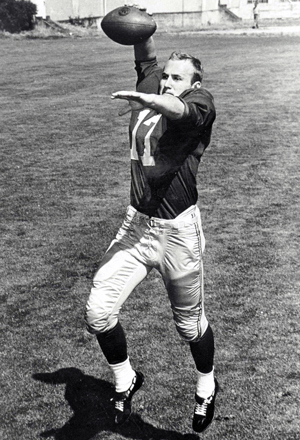 Jack Crabtree is one of the least well-known quarterbacks from the University of Oregon, but led the team to one of its famed accomplishments – the 1958 Rose Bowl, where the Ducks nearly pulled off a huge upset.
Jack Crabtree is one of the least well-known quarterbacks from the University of Oregon, but led the team to one of its famed accomplishments – the 1958 Rose Bowl, where the Ducks nearly pulled off a huge upset.Crabtree grew up in Southern California and moved to Eugene from San Bernardino Junior College in time for the 1955 season.
At 6-feet, 180 pounds, he played three seasons for the Oregon varsity, and was the starter at quarterback as a senior when the Ducks went 7-3 and tied Oregon State for the Pacific Coast Conference title. Conference rules gave the Ducks, who lost to the Beavers 10-7 at the close of the regular season, the Rose Bowl berth because OSU had been to the game the previous year.
During the season, Crabtree attempted just 99 passes and threw for four touchdowns, but the Ducks averaged 295 yards of offense per game and he was named all-conference honorable mention.
In the Rose Bowl, Crabtree completed 10 of 17 passes for 135 yards and also played defense against Ohio State, ranked No. 1 and favored to win by 19 points. Although Oregon lost 10-7, the Ducks carried coach Len Casanova off the field on their shoulders and Crabtree was named the game’s MVP, only the third player at the time to be so honored from the losing team.
Crabtree served two years in the Army before attempting to play in the American Football League with both the Denver Broncos and Los Angeles Chargers. He did not see any action and retired to work in the athletic supply business.
Crabtree was inducted to the Oregon Sports Hall of Fame in 1981 and the University of Oregon Athletics Hall of Fame in 2002.
- Don Durdan - Football
-
1981
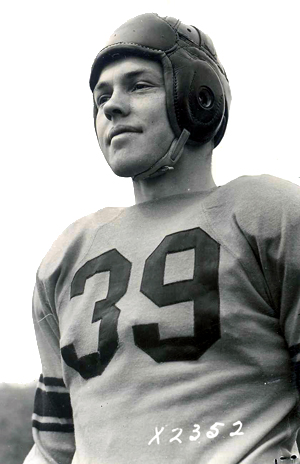 Don Durdan remains one of Oregon State’s most versatile and inspiring athletes, having played football, basketball and baseball despite usually being the shortest player on his team.
Don Durdan remains one of Oregon State’s most versatile and inspiring athletes, having played football, basketball and baseball despite usually being the shortest player on his team.Born in 1920, Durdan grew up in Eureka, Calif., and was a member of the Eureka High “Wonder Team” that did not allow a point during the 1935 season. He reached Oregon State in 1938 as a 5-foot-9, 175-pound halfback and played for the varsity in 1939-41, an era that included a win in the Pineapple Bowl and Rose Bowl.
In the ’42 Rose Bowl, Durdan ran for 54 yards and a touchdown and played enough other roles such as punter to be named the game’s Most Valuable Player, retroactively since the award didn’t exist at the time of the game.
Durdan played for the basketball team under coach Slat Gill from 1940-43, and was voted All-American in 1943. The 1941-42 team won the Pacific Coast Conference Northern Division title despite missing Durdan for several weeks due to the Rose Bowl. He also played for the baseball team under Ralph Coleman in 1941 and ’42. Durdan served in the Navy during World War II.
In 1946, Durdan signed with the San Francisco 49ers of the All-American Football Conference and played as a halfback, punter and defensive back. He then returned to Oregon to play for the Portland Indians of the expansion Pacific Coast Professional Basketball League. He played one game for the 49ers in 1947 before returning to Oregon to play for the Indians for a second season before the league collapsed.
Following his two stints as a professional, he ran a funeral home in Corvallis until passing away in 1971.
Durdan was inducted to the Oregon Sports Hall of Fame in 1981 and the Oregon State Athletics Hall of Fame in 1988.
- Brad Ecklund - Football
-
1981
 Brad Ecklund played his way into Oregon lore as one of its most versatile athletes and characters, starring on the field, in the ring, on the sidelines and even on the silver screen. Born in Los Angeles in 1922, Ecklund graduated from Milwaukie High School as a star in football, basketball and baseball and found his way to the University of Oregon in 1941.
Brad Ecklund played his way into Oregon lore as one of its most versatile athletes and characters, starring on the field, in the ring, on the sidelines and even on the silver screen. Born in Los Angeles in 1922, Ecklund graduated from Milwaukie High School as a star in football, basketball and baseball and found his way to the University of Oregon in 1941.At 6-foot-3, Oregon coach Tex Oliver moved Ecklund from fullback to center and he started as a freshman. Academics caused Ecklund to leave school and join the military, where he served in the Marines during the Island Hoping campaign in the South Pacific. Ecklund also took up boxing and became the Marine Corps Golden Gloves champion. He returned to Oregon following the war and played three more seasons: 1946-48, and helped lead the Ducks, with Norman Van Brocklin at quarterback, to the 1949 Cotton Bowl, which they lost 20-13 to Southern Methodist.
During his senior season, Ecklund, at age 26, regularly played on both offense and defense and was on the field for every minute of five games. He was voted All-Pacific Coast Conference in those three seasons.
Ecklund, who had been drafted by the Green Bay Packers following the 1946 season, signed with the New York Yankees of the All-America Football Conference in 1949 and played one season in the AAFC before it merged with the National Football League. He played four more seasons in the NFL in New York, Dallas and Baltimore. In five pro seasons, Ecklund started at center in all 60 games, played in the Pro Bowl twice and earned the nickname “Whitey” due to his white hair.
After five seasons, Ecklund returned to Oregon to coach high school football and moved to the University of Oregon sidelines under coach Len Casanova in 1957. Ecklund helped the Ducks reach the Rose Bowl in 1958, then moved to the NFL under Dallas coach Tom Landry in 1960. He was an assistant to Van Brocklin in Atlanta in 1968.
Ecklund coached in the NFL with five teams for 20 seasons, and had an uncredited role in the 1979 feature film North Dallas Forty.
Upon retiring, he became a substitute teacher in New Jersey.
Ecklund was inducted to the Oregon Sports Hall of Fame as part of its second class in 1981. He was inducted to the University of Oregon Sports Hall of Fame in 1999.
Ecklund died in 2010.
- Joe Francis - Football
-
1981
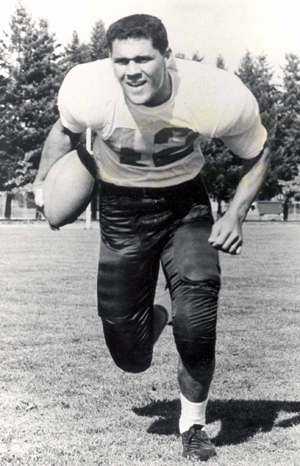 Joe Francis ran and passed Oregon State to the 1957 Rose Bowl and then played professionally in both the NFL and CFL.
Joe Francis ran and passed Oregon State to the 1957 Rose Bowl and then played professionally in both the NFL and CFL.Born in 1936, Francis grew up in Hawaii and was recruited to Corvallis by coach Kip Taylor. He remained at the school after Tommy Prothro became coach in 1955. Francis played halfback from 1955-57, but frequently threw passes in the Beavers’ run-based offense. In 1956, the Beavers lost two of their first three games, but then won six consecutive games to claim a spot in the Rose Bowl. They tied their final regular-season game, 14-14, against Oregon while playing before a national television audience on NBC. In the Rose Bowl, Francis had 207 yards of total offense, but OSU lost to Iowa 35-19, and finished No. 10 in the final Associated Press poll – its highest ranking at the time.
Oregon State went 8-2 in ’57 with Francis being named team MVP as he had been the previous season.
The Green Bay Packers selected him in the fifth round of the 1958 NFL Draft and he played two seasons under Coach Vince Lombardi as back-up for Bart Starr. He played two seasons, 1961-62, for the Montreal Alouettes in the CFL before returning to Hawaii to become a Physical Education teacher and football coach.
Francis fathered two sons, Jon and Ikaika, who played in the NFL.
Francis was inducted to the Oregon Sports Hall of Fame in 1981 and the Oregon State Athletics Hall of Fame in 1991.
- Quentin Greenough - Football
-
1981
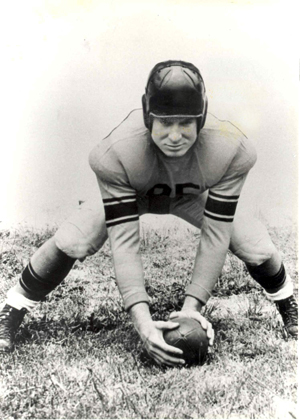 Quentin Greenough earned his place in state sports lore as center for Oregon State’s first Rose Bowl team.
Quentin Greenough earned his place in state sports lore as center for Oregon State’s first Rose Bowl team.Born in 1919, Greenough grew up in San Gabriel, Calif., and played three seasons for the Beavers, 1939-41. As a sophomore, he helped Oregon State finish 9-1-1 and score a win in the 1940 Pineapple Bowl, played in Honolulu, Hawaii.
In 1941, Greenough helped the Beavers finish 8-2, including a win over Duke in the 1942 Rose Bowl, which was played in Durham, N.C., due to the threat of invasion from the Japanese army.
In the third game of the season, Greenough played on both offensive and defensive lines and led the Beavers to a 10-0 upset of Stanford, which had played in the previous Rose Bowl and was a heavy favorite to play in the game again. He played until the fourth quarter, when a dislocated knee forced him from the field.
During the regular season, the Beavers allowed just 33 points before beating second-ranked and unbeaten Duke 20-16. Oregon State finished 12th in the final national rankings, which were produced before any bowl games.
Greenough was voted second team All-American.
He served in the United States Coast Guard and played for the USCG football team in ’42 and ’43.
Following the war, Greenough returned to Corvallis and served as an assistant to coach Lon Stiner until Stiner was released in 1948. Greenough later established a general contracting business in Corvallis.
Greenough was inducted to the Oregon Sports Hall of Fame in 1981 and the Oregon State Athletics Hall of Fame in 1991.
- Howard Maple - Football
-
1981
 Howard Maple earned the distinction of being the only Oregon State alum to ever play in both the NFL and Major Leagues after graduating from the school in 1928.
Howard Maple earned the distinction of being the only Oregon State alum to ever play in both the NFL and Major Leagues after graduating from the school in 1928.
Born in Missouri in 1903, Maple found his way to Oregon State and lettered from 1926-28 as a halfback, earning recognition as a second-team All-American following his senior season. During his years in Corvallis, the Beavers were a combined 16-7-1, with three of the losses coming to USC.
Maple played eight games with the Chicago Cardinals of the NFL in 1930, and hit .244 in 44 games as a catcher with the Washington Senators in 1932.
He was inducted to the Oregon Sports Hall of Fame in 1981 and the Oregon State Athletics Hall of Fame in 1990.
- Adolphe Schwammel - Football
-
1981
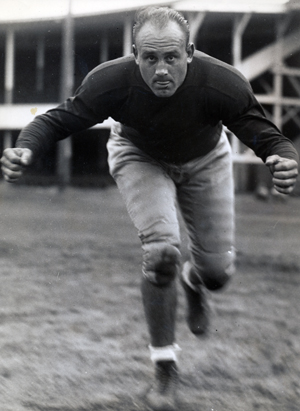 Adolphe Schwammel played three seasons at Oregon State, then won two NFL titles in five seasons with the Green Bay Packers.
Adolphe Schwammel played three seasons at Oregon State, then won two NFL titles in five seasons with the Green Bay Packers.Born in 1908, Schwammel grew up in Oakland, Calif., and played on the offensive line at OSU from 1931-33. In those years, the Beavers were a combined 16-9-3. In '33, the Beavers tied USC 0-0, using the same 11 players for the entire game, and traveled to New York City to beat Fordham 9-6 before 45,000 fans. Schwammel played in the East-West Shrine Game in 1934.
Schwammel played two stints as a lineman and back-up place-kicker with the Packers, 1934-36, and '43-44, with a seven-year break for military service. They won the NFL Championship game in both 1936, and '44. He was voted first-team All-Pro in 1935.
Schwammel was voted to the Oregon Sports Hall of Fame in 1981 and the Oregon State Athletics Hall of Fame in 1990.
- Dick James - Football
-
1981
Richard "Dick" Alwin James (May 22, 1934 – June 28, 2000) played halfback and defensive back in the National Football League for the Washington Redskins, New York Giants, and the Minnesota Vikings. He played college football at the University of Oregon and was drafted in the eighth round of the 1956 NFL Draft.
He set a team record with four touchdowns in one game as the Redskins beat the Dallas Cowboys, 34-24 in 1961. He scored 34 touchdowns in his National Football League career. James was one of the smallest players in the NFL at 5-9 and 175 pounds. James was also known as gymnast, performing such acts as walking on his hands down flights of stairs before games. He died in 2000 of prostate cancer at the age of 66.
He had a short stint as a sports announcer in the Washington DC area after he retired mainly covering the Redskins on game day.
- Woodley Lewis - Football
-
1981
Woodley Carl Lewis, Jr. (June 14, 1925 – December 29, 2000) played end, wide receiver, and defensive back in the National Football League. He played eleven seasons for the Los Angeles Rams, Chicago Cardinals, and Dallas Cowboys. He played college football for the University of Oregon.
In 1948, he was a teammate of Norm Van Brocklin and was the starting halfback (he missed 3 games with an injury). Oregon tied with California for the title of the Pacific Coast Conference, forerunner of the Pac-12. California was undefeated overall, and Oregon's only loss was at undefeated Michigan, that year's national champions. Oregon did not go to the Rose Bowl, however, because Cal was voted by the other schools to represent the PCC in the game. They would lose 21-13 in the Cotton Bowl against Southern Methodist University. He also became the first African-American to play in the Cotton Bowl Stadium. In 1949, he led the nation in kickoff returns, ranked seventh in pass interceptions (8) and led his team in rushing with 473 yards (6.8-yard average).
He finished his college eligibility as the school's record-holder in career kickoff return average (34.1 avg.), single-season return average (43.2), career rushing yards per carry (5.6), longest punt return (92 yards against Oregon State, 1949) and longest kickoff return (102 yards against Colorado, 1949).
In 1999, he was inducted into the University of Oregon Athletics Hall of Fame.
- Percy Locey - Football
-
1981
Percy P. Locey (November 28, 1894 – August 1981) was a player, coach, and a college athletics administrator. He served as the head football coach at the University of Denver from 1932 to 1935. He was the athletic director at Oregon State College from 1937 to 1947. Locey was inducted into the Oregon State University Sports Hall of Fame in 1990.
Locey enrolled at Oregon State in 1915 and played competitive football as a freshman. His career and education, however, was put on hold for a short period during World War I. Returning to Oregon State in 1921, he became an outstanding tackle on the Oregon State Aggies football team. Locey lettered in 1915 and again from 1921 to 1923 and was team captain in 1923. Locey was chosen to play in the 1925 East-West Shrine Game for his on-field achievements. He also served as student body president his senior years at Oregon State (1923–24).
In 1926, Locey played football at the Olympic Club in San Francisco. He was a member of the Olympic's "Winged-O" football eleven that handed the University of California's Wonder Team" their first loss in five seasons.
In 1928, Locey took over as the head football coach at the Olympic Club in San Francisco. His next head coaching position was at the University of Denver, where he spent four seasons and posted an overall record of 20–14–3, never having a losing season.
In 1937, Locey returned to Corvallis to become the athletic director at his alma mater. His most significant achievement as athletic director may have occurred shortly after the Beavers won the Pacific Coast Conference title in 1941, earning the right to play in the 1942 Rose Bowl against Duke. As Beaver fans hurried to buy tickets to the game in Pasadena, the attack on Pearl Harbor by Japan on December 7 soon put the game's future in doubt. The Army canceled the game, citing the potential of the game as a target, leaving Locey and Oregon State to scramble to find an alternative site. Locey chose Duke's home campus in Durham, North Carolina, and then oversaw the refund and reissue of game and train tickets as well as hotel reservations for the Beaver faithful. Despite being 3-to-1 underdogs, the Beavers upset Duke, 20–16, in what remains the Beavers' only Rose Bowl victory.
Locey stepped down as athletic director in 1947.
- Bill Morgan - Football
-
1981
Elmer William "Bill" Morgan (May 8, 1910 – July 10, 1985) played offensive linemen (6'2" and 232 lbs.) for four seasons for the New York Giants, from 1933-1936, appearing in 48 games. He was a member of the New York Giants 1934 NFL Championship team. Morgan was a two-time All-Pro.
Born in Portland, Oregon, Morgan attended high school at Medford High School in Medford, Oregon and played college football for the University of Oregon in 1932. He also played in the East-West Shrine Game.
- Raymond “Butch” Morse - Football
-
1981
Raymond Joseph "Butch" Morse (December 5, 1910 – May 22, 1995)
Born in Cleveland, Ohio, Morse later moved to Portland, Oregon, where he graduated from Benson Polytechnic High School in 1931. In addition to football, where he was MVP on Benson's 1928 city championship team, he played baseball and was the leading scorer for the school's basketball team in 1930.
Morse attended the University of Oregon, where he was a two-time All-Pacific Coast Conference end, and an All-American in his senior year of 1934, when he was also team co-captain.
Morse signed with the Detroit Lions in 1935, the year the Lions won their first NFL Championship. Morse played for the Lions until 1940, when he was drafted into the United States Army Air Corps. In 1944, he was an assistant coach for the Air Corps' Randolph Field Flyers in the 1944 Cotton Bowl Classic, in which the Flyers tied the heavily favored Texas Longhorns, 7–7.
He was named to the PIL Hall of Fame in 2004 and inducted into the University of Oregon Athletic Hall of Fame in 1997.
1982
- Bill Austin - Football
-
1982
 Bill Austin turned his experience at Oregon State into a distinguished career in the National Football League as both a player and coach.
Bill Austin turned his experience at Oregon State into a distinguished career in the National Football League as both a player and coach.Born in 1928, Austin grew up in San Pedro, Calif., and reached Oregon State as a 16-year-old. He played offensive lineman for the Beavers for four seasons (1945-48), eventually filling out to 6-foot-1, 225 pounds.
In 1946, the Beavers were 7-1-1, losing only to UCLA. They tied Stanford. As a senior, he was voted to the All-Pacific Coast Conference team and played in the 1949 East-West Shrine Game. During his years in Corvallis, the Beavers were a combined 21-14-5.
The New York Giants drafted Austin, who earned a degree in biology, in 1949. He played seven seasons for the Giants, missing the 1951 and ’52 seasons while serving in the military during the Korean War.
Upon his return, Austin excelled and played in the Pro Bowl in 1954. His playing career ended in 1957, but he immediately became an assistant coach.
In New York, Austin played under Vince Lombardi, who was an assistant, and was one of 17 players from the 1950s Giants to become coaches in the league. Austin became the offensive line coach for the Green Bay Packers when Lombardi took over the team in 1959. In Austin’s six years in Green Bay, the Packers reached the NFL Championship game three times and won twice. He coached the offensive line for the Los Angeles Rams in 1965 before being named head coach of the Pittsburgh Steelers in 1966, where his teams went a combined 11-28-3 in three seasons. Upon his dismissal, Austin rejoined Lombardi, this time with the Washington Redskins in 1969. Upon Lombardi’s death the following year, Austin coached the team for one season.
Austin coached the offensive line with the New York Giants from 1979-82 before retiring from coaching.
In four years as a head coach, Austin finished 17-36-3.
Following his career, he moved with his wife to La Mesa, Calif., and became a business owner.
Austin was inducted to the Oregon Sports Hall of Fame in 1982 and into the OSU Athletics Hall of Fame in 1990.
- Del Bjork - Football
-
1982
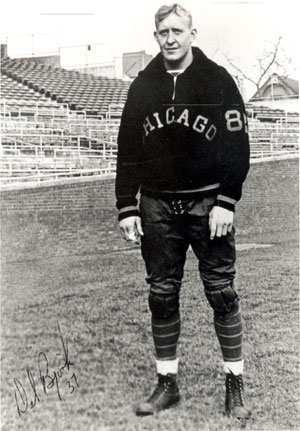 Del Bjork played his way from the Oregon coast to the Willamette Valley and into the NFL.
Del Bjork played his way from the Oregon coast to the Willamette Valley and into the NFL.Born in 1914, Bjork grew up in Astoria and filled out into a 6-foot-1, 218-pound lineman during a sparkling athletic era for the high school, which won four state basketball titles in six years beginning in 1930.
Bjork played for Oregon from 1934-36, when the Ducks were a combined 14-13-1. Despite Oregon’s 2-6-1 record in 1936 (the team scored just 34 points), Bjork’s play earned him postseason action in the East-West Shrine Game. He also played in the 10th Collegiate-Pro Classic, and helped the college team beat the Green Bay Packers 6-0.
The Chicago Bears drafted Bjork in the sixth round of the 1937 NFL Draft, only the league’s second draft, and he played there for two seasons. He was the second UO player drafted, following guard Ross Carter in the 1936 Draft.
He served in the North Pacific during World War II.
Bjork died in 1988. He was inducted to the Oregon Sports Hall of Fame in 1982.
- Ken Carpenter - Football
-
1982
 Ken Carpenter had one of the more memorable pro careers of any Oregonian, playing in the NFL, the CFL and in the first year of the AFL.
Ken Carpenter had one of the more memorable pro careers of any Oregonian, playing in the NFL, the CFL and in the first year of the AFL.
Born in Seaside in 1926, Carpenter grew to be 6-foot, 195 pounds and played running back from 1946-49 at Oregon State, amassing 3,903 all-purpose yards. He impressed professional scouts enough to be selected No. 13 in the 1950 NFL Draft by Cleveland, and scored 17 touchdowns as a back, receiver and kick returner in four seasons with the Browns. He was named to the NFL Pro Bowl in 1951.
Carpenter then played six seasons in the Canadian Football League for the Saskatchewan Roughriders before being signed by the Denver Broncos in time for the inaugural season of the American Football League in 1960. He caught 29 passes in six games before retiring.
He was named an NFL Pro Bowler in 1951.
Carpenter was inducted to the Oregon Sports Hall of Fame in 1982 and the Oregon State Athletics Hall of Fame in 1991.
- Jim Dixon - Football
-
1982
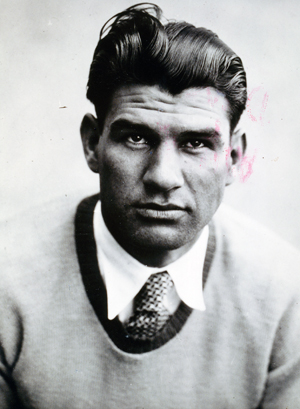 Jim Dixon was an All-American lineman during his career at Oregon State and then served as an assistant football coach and head wrestling coach long enough that the school named a building after him.
Jim Dixon was an All-American lineman during his career at Oregon State and then served as an assistant football coach and head wrestling coach long enough that the school named a building after him.
Dixon played left tackle at OSU under coach Paul Schissler from 1924-26 and was an All-American and All-Coast selection as a senior.He returned to campus as an assistant coach in 1933 under Schissler’s successor, Lon Stiner, and remained in that position for 14 seasons, including the Rose Bowl year, 1941-42. Dixon also served as head coach of the wrestling program from 1934-38, and again from 1952-55.
Due to his long service, Oregon State named its campus recreation center after him. Today it’s known as the Dixon Recreation Center.
Dixon was inducted to the Oregon Sports Hall of Fame in 1982 and the Oregon State Athletics Hall of Fame in 1990.
- George "Gap" Powell - Football
-
1982
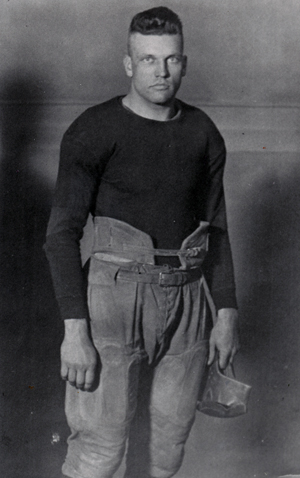 George "Gap" Powell played, coached and recruited for Oregon State during his lifetime on the Pacific Coast.
George "Gap" Powell played, coached and recruited for Oregon State during his lifetime on the Pacific Coast.
Powell, born in 1898, was part of the first graduating class from Portland's Franklin High School, and played fullback at Oregon State from 1918 to 1921, earning the distinction of being the school's first All-American as a senior. He also won the Pacific Coast Conference title in the shot put following his junior season.After graduating he coached the team to a 3-4 record in 1922, then moved to Southern California and became a business owner distributing oil and gas. During his business career, he promoted OSU to athletes throughout California and became known as "Mister Oregon State."
Powell was inducted to the Oregon Sports Hall of Fame in 1982, and the Oregon State Athletics Hall of Fame in 1990.
- Aaron Thomas - Football
-
1982
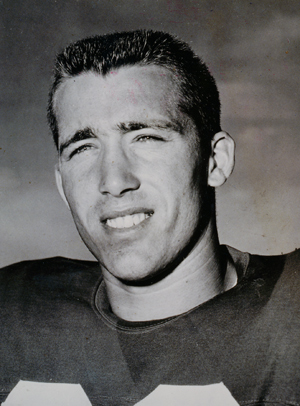 Aaron Thomas had an all-star career at Oregon State and in the NFL before becoming an ardent Beavers’ booster.
Aaron Thomas had an all-star career at Oregon State and in the NFL before becoming an ardent Beavers’ booster.Born in 1937, Thomas played receiver at OSU from 1958-60. He played in the East-West Shrine Game following his junior season, and the College All-Star Game, Coaches All-America Bowl, and the Senior Bowl following the '60 season.
Thomas was selected by the San Francisco 49ers in the NFL Draft and Dallas Texans in the AFL Draft, and chose to sign with San Francisco. He played receiver with San Francisco, and tight end with the New York Giants after being traded during the '62 season, which ended with the Giants losing toGreen Bay in the NFL Championship game.
In 10 years, Sears caught 262 passes for 4,554 yards and 37 touchdowns. He was named to the Pro Bowl in 1964, despite the Giants finishing 2-10. In his career, he missed just seven games.
Upon returning to Oregon, Thomas served as the assistant director of the Beaver Club from 1983-89. He was inducted into the State of Oregon Hall of Fame in 1982, and the Oregon State Athletics Hall of Fame in 1990.
- Vern Burke - Football
-
1982
Vern Burke played tight end and receiver alongside Terry Baker at Oregon State and then played professionally for three teams in the National Football League.
Born in 1941, Burke grew up in Bakersfield, Calif., where he attracted the attention of Oregon State coach Tommy Prothro. During his senior season, 1962, he caught 69 passes for 1,007 yards and was named All-America the same year that Baker won the Heisman Trophy. Oregon State won the Liberty Bowl that season.
Following the season, Burke played in the East-West Shrine Game and the Hula Bowl and was selected by the San Francisco 49ers in the fifth round of the 1963 NFL Draft. He played one season each for the 49ers, Atlanta Falcons and New Orleans Saints before retiring at age 27.
Burke was inducted to the Oregon Sports Hall of Fame in 1982 and the Oregon State Athletics Hall of Fame in 1991.
- Dave Grayson - football
-
1982
David Lee Grayson (June 6, 1939 – July 29, 2017) was a defensive back in the American Football League for the Dallas Texans and the National Football League for the Kansas City Chiefs and Oakland Raiders. He played college football at the University of Oregon.
After high school he went on to play at San Diego City College. Besides football, he was a part of the 4 x 200 relay team that set a national junior college record. As a junior, he transferred to the University of Oregon, where he played offensive and defensive halfback. In 2010, he was inducted into the Breitbard Hall of Fame.
Grayson played four years with the Dallas Texans/Kansas City Chiefs. In 1961, he set the franchise and AFL record for the longest interception return with a 99-yarder against the New York Titans. In 1961, he also led the league in kickoff returns. In 1962 and 1963, he finished second in the league in kickoff returns.
He had an interception off George Blanda in the Texans' classic 1962 double OT championship game victory over the defending AFL Champion Houston Oilers. Grayson was an AFL All-Star six times, with the Texans/Chiefs in 1962, 1963, and 1964, and with the Raiders in 1965, 1966, and 1969.
He made a 48-yard return with the opening kickoff against the Oilers in the 1967 AFL Championship Game, helping his team win the game and reach Super Bowl II. In 1968, he led the AFL with 10 interceptions. His 29 interceptions rank seventh all-time in Raiders history.
Grayson is the All-time AFL leader in interceptions with 47, for a 20-yard return average and 5 touchdowns, and he averaged 25.4 yards on 110 kickoff returns. He is a member of the AFL All-Time Team.
- Hal Moe - Football
-
1982
Harold W. Moe (March 28, 1910 – May 26, 2001)
Born in Spokane, Washington, Moe went on to attend Oregon Agricultural College, now Oregon State University, where he played halfback on the school's football team from 1929 to 1932. Upon the conclusion of his career at Oregon State, he played one season in the National Football League for the Chicago Cardinals.
After one season in the NFL, Moe returned to Corvallis, Oregon to become an assistant football coach at Oregon State. He remained with the team in that role from 1933 until the Beavers' appearance in the 1942 Rose Bowl, after which he joined the military and served in the Pacific Theater of World War II.
Following the war, Moe returned to Portland in 1946 and became the head football coach and athletic director at the University of Portland, where he remained until 1948, a year before the school ended its football program. He returned to Oregon State as an assistant football coach from 1949 to 1952, and then became the school's head track and field coach from 1952 to 1958.
Moe was named to the Oregon State University Hall of Fame in 1990.
- Jack Patera - Football
-
1982
John Arlen Patera played and coached in the National Football League. He played for the Baltimore Colts, Chicago Cardinals, and Dallas Cowboys. He was an assistant coach for the Los Angeles Rams, New York Giants, and the Minnesota Vikings. Patera was the first head coach of the Seattle Seahawks, and his career head coaching record is 35–59–0 (.372), all with the Seahawks.
Patera attended Washington High School in Portland, Oregon. Upon graduation in 1951, he enrolled at the University of Oregon in Eugene, where he played college football for the Ducks from 1951–1954, earning All-Pacific Coast Conference honors as a guard in his senior year.
Other honors included his selection to play in the 1955 East-West Shrine Game, the Hula Bowl, and the College All-Star Game.
In 2000, he was inducted into the University of Oregon Athletics Hall of Fame.
1983
- Mel Renfro - Football
-
1983
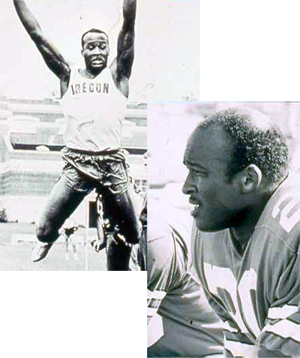 Mel Renfro established himself as a standout in high school, college and with a Hall of Fame career in the National Football League.
Mel Renfro established himself as a standout in high school, college and with a Hall of Fame career in the National Football League.Born in Houston in 1941, Renfro grew up in Portland and attended Jefferson High, where he starred in football and track and field.
With Renfro catching passes from quarterback and future Heisman Trophy winner Terry Baker, the Democrats won the state title in 1957 and ’58. Following Baker’s graduation and move to Oregon State, the Demos lost to Medford, 7-6, in the 1959 title game.
By then, Renfro had established himself as a track star as well, having won the 180-yard low hurdles at the 1959 state meet. As a senior, Renfro won the low hurdles, 120 high hurdles and long jump to power Jefferson, which won six events, to the team title.
Renfro played three seasons at Oregon, 1961-63, as both a defensive back and running back. In his career, he rushed for 1,540 yards and led the Ducks in scoring each season. As a senior, he won the Maxwell Award as the nation’s top running back and helped the Ducks finish 8-3 and play in the Sun Bowl. Renfro is still among the Oregon career leaders in all-purpose yardage.
In 1962, he finished second in the high hurdles and third in the long jump to help the Ducks win the NCAA Track and Field Championship. He ran a leg on the 440-yard relay team that set a world record at 40.0 seconds.
The Dallas Cowboys selected him in the second round of the 1964 NFL Draft and he played 14 seasons for the team as a defensive back. Renfro excelled on special teams returning kicks for several seasons, but played primarily as a cornerback, eventually establishing a franchise record for interceptions with 52.
In his 14 seasons, he was named to the Pro Bowl 10 times and All-Pro five times. Renfro played in the Super Bowl four times with the Cowboys winning twice, Super Bowl VI and XII.
Renfro was the fifth Dallas player inducted into the Ring of Honor at Cowboys Stadium. He currently works as a motivational speaker.
Renfro was inducted into the Oregon Sports Hall of Fame in 1983, and into the University of Oregon Sports Hall of Fame in 1992. He was enshrined in the NFL Hall of Fame in 1996.
- Dave Wilcox - Football
-
1983
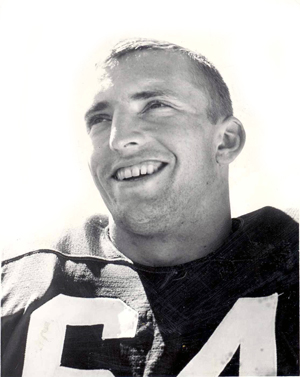 Dave Wilcox played his way from eastern Oregon into the National Football League Hall of Fame as an intimidating lineman and linebacker.
Dave Wilcox played his way from eastern Oregon into the National Football League Hall of Fame as an intimidating lineman and linebacker.Born in 1942, Wilcox grew up in Vale and graduated in 1960 having led the Vikings to three state title games, with wins in ’58 and ‘59. On his way to 6-foot-3, 240 pounds, Wilcox played two seasons at Boise Junior College, (now Boise State) as an offensive and defensive lineman before transferring to Oregon for the 1962 season. Oregon went 6-3-1 in ’62, losing only to Texas, Ohio State and Oregon State.
In ’63, the Ducks featured quarterback Bob Berry as well as defensive back Mel Renfro and finished 8-3, including a 21-14 win over Southern Methodist in the Sun Bowl.
Wilcox played in the Hula Bowl following his senior season and was voted outstanding lineman. He also played in two other college all-star games before being selected in both the NFL and AFL drafts.
Wilcox signed with the San Francisco 49ers in 1964 and played there for 11 seasons, being named to the Pro Bowl team seven times and the All-NFL team four times at linebacker. In his 11 seasons, the 49ers reached the playoffs three times, 1970-72, thanks primarily to the team’s defense. They were eliminated from the playoffs by the Dallas Cowboys each season.
Wilcox was voted to the Oregon Sports Hall of Fame in 1983 and the University of Oregon Sports Hall of Fame in 1993. He was enshrined in the NFL Hall of Fame in 2000.
- John Witte - Football
-
1983
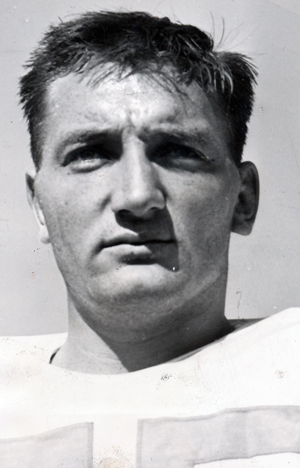 John Witte made a name for himself as a standout lineman on Oregon State’s 1957 Rose Bowl team as well as a national-caliber wrestler.
John Witte made a name for himself as a standout lineman on Oregon State’s 1957 Rose Bowl team as well as a national-caliber wrestler.Witte played under coach Kip Taylor in 1951-52 before joining the military during the Korean War. He returned to play under Tommy Prothro and was a two-time All-American (1955-56), helping the Beavers reach the Rose Bowl.
Witte wrestled in 1952 and again in ’56 with his success coming in ’52 when he won the Pacific Coast Conference title at heavyweight. He finished second in the NCAA meet.
Witte signed with the Saskatchewan Roughriders of the Canadian Football League in 1957 and played one season before retiring.
Witte was inducted to the Oregon Sports Hall of Fame in 1983 and the Oregon State Athletics Hall of Fame in 1991.
1986
- Emery Barnes - Football
-
1986
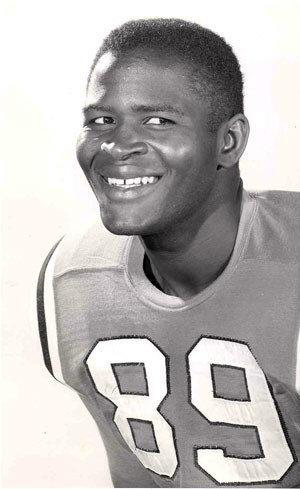 Emery Barnes created a legacy as an athlete and social leader in both Oregon and Canada that will last.
Emery Barnes created a legacy as an athlete and social leader in both Oregon and Canada that will last.Born in 1929, Barnes was raised in Louisiana and then Oregon, where he played football and ran track and field at Jefferson High School. He set the state high school record in the high jump in 1948 at 6-foot-2½ inches, a record that stood until 1960.
Barnes moved to the University of Oregon in 1950 as both a 6-foot-6 defensive end on the football team and international-caliber high jumper.
In 1952, he shared the NCAA title in the high jump by clearing 6-8, then set a personal best of 6-9¾ in the AAU national championships. Barnes missed clearing the world record of 6-11, but earned a spot as an alternate on the U.S. team for the 1952 Olympic Summer Games. In the fall, Barnes was voted to the all-Pacific Coast Conference team at defensive end, and he was team captain for the ’53 season.
The Green Bay Packers drafted Barnes 18th overall in 1954, but he served two years in the military before joining the team. Barnes played just two games for the Packers in 1956, before moving to Canada.
Barnes revived his career with the British Columbia Lions from 1962-64, playing on the Grey Cup champions in his final season. Barnes then moved to social work and found his way into politics in 1972, when he was the first person of color to be elected to a legislative position in British Columbia.
Barnes was re-elected four times and served as Speaker of the Legislature from 1994-96. He died of cancer in 1998 at age 68.
Vancover, B.C., honored Barnes’ legacy by officially opening Emery Barnes Park in 2003. He was inducted to the Oregon Sports Hall of Fame in 1986 and the University of Oregon Sports Hall of Fame in 2008.
1987
- Bob Berry - Football
-
1987
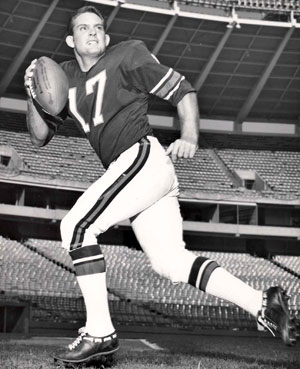 Bob Berry thrilled fans at Hayward Field as the second great quarterback for the University of Oregon, and played 11 years in the National Football League.
Bob Berry thrilled fans at Hayward Field as the second great quarterback for the University of Oregon, and played 11 years in the National Football League.Born in 1942, Berry grew up in San Jose, Calif., and was recruited by Len Casanova to where he played three seasons on the varsity (1962-64). In Berry’s junior season, the Ducks also featured receiver Mel Renfro and tight end Dave Wilcox and played their way into the Sun Bowl, where they beat Southern Methodist 21-14. In 1964, Berry was voted first-team All-American, and played in both the East-West Shrine Game and Hula Bowl after guiding the Ducks to a 7-2-1 record. He threw for 4,297 yards in his three seasons at Oregon.
The Philadelphia Eagles (NFL) and Denver Broncos (AFL) both drafted Berry in 1964, prior to his senior season, but he began his pro career with the Minnesota Vikings in 1965. At Minnesota, he played under coach Norm Van Brocklin, who starred at quarterback at Oregon from 1946-48. In three seasons as a back-up in Minnesota, he attempted just 46 passes.
Van Brocklin moved to Atlanta in 1968 and Berry moved with him as the starting quarterback. In Atlanta, Berry threw for 1,000 yards or more for five consecutive seasons and was voted to the Pro Bowl in 1969 despite playing in just seven of 14 games. He finished his career with three seasons as the back-up in Minnesota. In 11 seasons, he threw for 9,197 yards and 64 touchdowns.
He became a realtor following his playing career.
Berry was inducted to the Oregon Sports Hall of Fame in 1987 and the University of Oregon Sports Hall of Fame in 1992.
- Ahmad Rashad - Football
-
1987
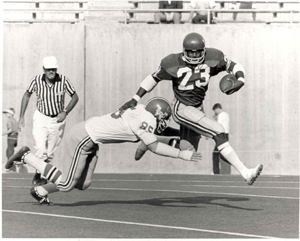 Ahmad Rashad played his way into the hearts of Oregonians as a standout running back and receiver for the University of Oregon, as a receiver in the NFL and then as a broadcaster on NBC.
Ahmad Rashad played his way into the hearts of Oregonians as a standout running back and receiver for the University of Oregon, as a receiver in the NFL and then as a broadcaster on NBC.Born in Portland in 1949, Rashad grew up in Tacoma, Wash., under his birth name, Bobby Moore. He moved to the University of Oregon in 1967, the year Autzen Stadium opened, and played on the varsity team from 1969-71. In those three years, the Ducks were a combined 16-15-2 and Moore set the school record for rushing (2,306 yards), receptions (131), all-purpose yardage (3,898) and scoring (226 points). He was named All-American in 1971.
The St. Louis Cardinals drafted Moore with the fourth pick of the ’72 NFL Draft and shortly thereafter he converted to Islam and changed his name to Ahmad Rashad.
Rashad played 10 seasons with four teams in the NFL and was voted to the Pro Bowl four times, including 1979 when he was a second-team All-NFL selection while with the Minnesota Vikings. In his 10 seasons, he caught 495 passes for 6,831 yards and scored 44 touchdowns.
After retiring, Rashad became a regular on NBC’s coverage of the NFL and then moved into the network’s coverage of the NBA.
Rashad was inducted to the Oregon Sports Hall of Fame in 1987 and the University of Oregon Sports Hall of Fame in 1992.
1988
- Steve Preece - Football
-
1988
Quarterbacked the Oregon State Beavers for three nationally ranked seasons from 1966-1968. Earned All-Coast and All Pac-8 honors. As offensive MVP, he led the Beavers to their "Giant Killer" 7-3 season in 1967, with wins over top ranked USC, Purdue, and a tie with UCLA.
He played nine years in the NFL as a defensive back. Played in three consecutive NFC championship games for the Los Angeles Rams, serving as defensive captain for the NFL's #1 ranked defense in 1973. Steve finished his career with the Seattle Seahawks in 1978.
1990
- Bob Grim - Football
-
1990
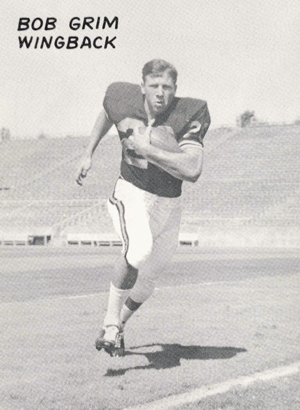 Bob Grim played a key role in helping Oregon State reach the 1965 Rose Bowl and then played 11 years in the NFL.
Bob Grim played a key role in helping Oregon State reach the 1965 Rose Bowl and then played 11 years in the NFL.
Born in 1945, Grim grew up in Red Bluff, Calif., and moved to Oregon State as a 6-foot halfback and kick returner. As a sophomore, Oregon State tied USC atop the Athletic Association of Western Universities standings and was voted into the Rose Bowl. Grim was voted to the Coaches All-America Bowl. As a junior, Grim played in the East-West Shrine Game, and the following season in the Senior Bowl, where he was named Outstanding Back.Selected in the second round by Minnesota in the 1967 NFL Draft, Grim played 11 seasons as a receiver with the Vikings, New York Giants and Chicago Bears. He played in Super Bowl IV and XI, both with Minnesota, and finished with 194 receptions for 2,914 yards and 16 touchdowns.
Grim was inducted to the Oregon Sports Hall of Fame in 1990 and the Oregon State Athletics Hall of Fame in 1991.
1991
- Bill McKalip - Football
-
1991
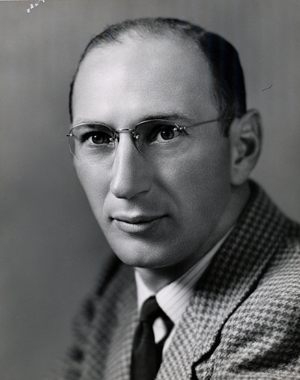 "Wild Bill" McKalip played at Oregon State from 1928-30, had four successful seasons in the NFL, and then returned to Corvallis as an assistant coach.
"Wild Bill" McKalip played at Oregon State from 1928-30, had four successful seasons in the NFL, and then returned to Corvallis as an assistant coach.
Born in Pittsburgh, Pa., in 1907, McKalip played halfback at OSU, helping the Beavers to a combined 18-10 record, including a 25-13 upset of New York University in 1928, and a 14-7 upset of Detroit the following season. The Beavers are frequently credited with being the first Western school to travel to the East for a game, and won despite being a 3-to-1 underdog. Their win over Detroit snapped that team’s 22-game winning streak.As a senior, McKalip earned All-Pacific Coast Conference First Team, Associated Press All-Northwest First Team, and United Press International All-Coast Second Team honors. He played in East-West Shrine Game in 1930.
McKalip signed with the Portsmouth, Ohio, Spartans for the 1931 and '32 NFL seasons, and, after the franchise became the Detroit Lions, played in 1934. After a season off, spent as a sports writing insider, he returned for one more season, 1936. In his four seasons, his team finished second in the league or conference twice and third the other two seasons.
McKalip returned to OSU as an assistant coach from 1937-41, and also served as an assistant in the basketball program. He was inducted to the Oregon State Athletics Hall of Fame in 1990 and the Oregon Sports Hall of Fame in 1991.
- Pete Pifer - Football
-
1991
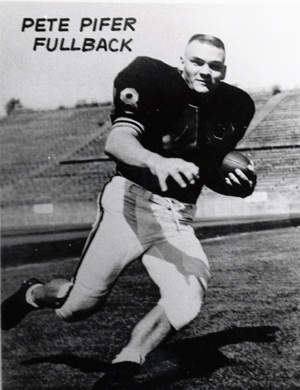 Pete Pifer ran for 1,000 yards twice while at Oregon State and finished his career as the school's all-time leading rusher.
Pete Pifer ran for 1,000 yards twice while at Oregon State and finished his career as the school's all-time leading rusher.
Pifer played at OSU from 1964-66, and was the first back to run for 1,000 yards, which he accomplished as a junior and senior. Pifer earned a spot in the East-West Shrine Game as a fullback in 1965, and the Hula Bowl in '66. As a senior, Pifer ran for 228 yards on 34 carries in a 31-12 win over Arizona, one week after running for four touchdowns in a 41-13 win over Washington State. He completed his career with 2,233 yards, and received the Pop Warner Award for top back on the Pacific Coast and the Voit Memorial Trophy for outstanding player on the Pacific Coast.
Pifer was inducted to the Oregon State Athletics Hall of Fame in 1990 and the Oregon Sports Hall of Fame in 1991.
1992
- Dan Fouts - Football
-
1992
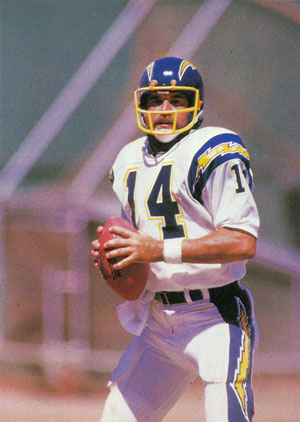 Among the players to come from an Oregon college, Dan Fouts ranks as one of the most well known for his transition to the professional ranks, both statistically and for his position within the national media.
Among the players to come from an Oregon college, Dan Fouts ranks as one of the most well known for his transition to the professional ranks, both statistically and for his position within the national media.Born in 1951, Fouts grew up in San Francisco, Calif., as the son of radio broadcaster Bob Fouts, who handled play-by-play duties for San Francisco 49ers games. Dan Fouts played for two private schools before accepting a scholarship to the University of Oregon.
At Oregon, the 6-foot-3 Fouts blossomed into one of the nation’s top passers and set 19 school records, including career passing with 5,995 yards. He threw 24 touchdown passes in 1970 and 54 from 1970-72. Oregon went 15-17-1 in those years.
From Oregon, Fouts moved to the San Diego Chargers, who selected him in the third round of the 1973 NFL Draft. He became the starting quarterback almost immediately for a team that finished with just two wins in 14 games and scored 6 points or less five times. Fouts passed for 1,126 yards and six touchdowns with 13 interceptions.
In 1978, the Chargers hired Don Coryell as coach and became a pass-oriented team behind Fouts, who threw for 2,999 yards and 24 touchdowns. The next season, Fouts threw for 4,082 yards and 24 touchdowns as the Chargers went 12-4, won the AFC West and reached the NFL playoffs for the first time since the AFL and NFL merged.
San Diego won the AFC West the next two seasons and reached the AFC championship game in ’80 and ’81, but lost both games.
Fouts was selected as the league Offensive Player of the Year in 1982 – a season shortened to six games by strike. The team struggled to win the next five years and Fouts retired in 1987 at age 36.
In his 15 seasons, Fouts passed for 43,040 yards and 254 touchdowns. The Chargers retired his number (14), and fans voted him the “Greatest Charger of All-Time” in 2009. Following his retirement, Fouts became a television broadcaster working on NFL games as both a play-by-play and color commentator. His broadcast career included a role on ABC’s Monday Night Football.
Dan Fouts was inducted to both the University of Oregon and Oregon Sports Hall of Fame in 1992. He was inducted to the NFL Hall of Fame in 1993.
1993
- Russ Francis - Football
-
1993
 Russ Francis, a multi-sport Pleasant Hill High School graduate, became a star tight-end down the road at the University of Oregon. At Oregon in 1974, Francis was named First Team All-Pac 8 and honorable mention All-American while ranking third in the conference with 31 catches (495 yards).
Russ Francis, a multi-sport Pleasant Hill High School graduate, became a star tight-end down the road at the University of Oregon. At Oregon in 1974, Francis was named First Team All-Pac 8 and honorable mention All-American while ranking third in the conference with 31 catches (495 yards). Francis was drafted in the first round (16th pick overall) by the New England Patriots, where he had 206 receptions for 1996 yards (average 14.5 a catch) and 28 touchdowns (1975-1980). He moved to the San Francisco 49ers (1982-87), where he had 186 receptions for 2105 yards (average 11.3 yards a catch), 12 touchdowns, and earned the prized Super Bowl Ring in 1985. Francis’s sticky fingers made him one of the most prolific receivers in the NFL for over a decade. Francis currently lives in California.
- Neil Lomax - Football
-
1993
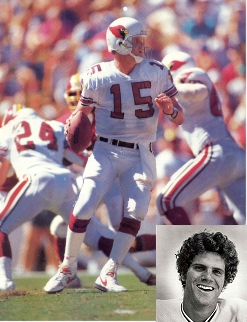 Neil Lomax started his fabled career on the fields of Lake Oswego High School. At Portland State University (1977-80), he started his freshman year as the Viking’s fifth string quarterback. After nine games, he took the helm. As a senior, he led the NCAA Division I-AA football in total yards (4,094), touchdown passes (37) and completions (296, and was seventh in the Heisman Trophy balloting. He remains second on the all-time total NCAA passing yards list.
Neil Lomax started his fabled career on the fields of Lake Oswego High School. At Portland State University (1977-80), he started his freshman year as the Viking’s fifth string quarterback. After nine games, he took the helm. As a senior, he led the NCAA Division I-AA football in total yards (4,094), touchdown passes (37) and completions (296, and was seventh in the Heisman Trophy balloting. He remains second on the all-time total NCAA passing yards list. Drafted by the St. Louis Cardinals (1981-88), Lomax’s 82.7 career passing efficiency rating ranks ninth on the NFL’s All-Time Quarterback Ratings and his 4,614 passing yards (1984) ranks fifth highest for a single season in NFL history. Lomax earned pro bowl honors in 1984 and 1987. Lomax’s voodoo with the football avoids description on paper, but fan’s minds nationwide are filled with his countless acts of poetry.
1996
- Ted Bates - Football
-
1996
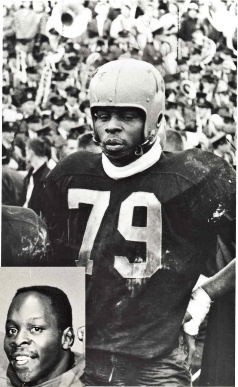 Oregon State standout Ted Bates was selected for two All-American first teams. He played in the 1957 Rose Bowl, the 1958 East-West Shrine games, and the Hula Bowl, and was named to the All-Coast team.
Oregon State standout Ted Bates was selected for two All-American first teams. He played in the 1957 Rose Bowl, the 1958 East-West Shrine games, and the Hula Bowl, and was named to the All-Coast team.Drafted by the Cardinals in 1959, Bates played for them in Chicago and St. Louis through 1963. He ended his professional career as a Washington Redskin. He received the 1958 Hayward Award as Oregon’s outstanding amateur athlete.
1999
- Reuben Sanders - Football
-
1999
Records are not available, but it not likely that any football player ever played in more games than did Reuben Sanders, the great Indian athlete. A career that started in 1895 and ended when Sanders played his last football game again the Multnomah Athletic Club. After completing his studies at the Chemawa Indian School, Sanders played with Willamette University and then the Capital City Athletic Club of Salem, the Multnomah Athletic Club team and with the Sherman Indians. Sanders, a wiry athlete of about 175 pounds, played as many as three games a week. After his football career ended, he turned his attention to coaching and assisted in the mentorship of football,
basketball and baseball teams at Chemawa until he retired at the age of 65. Sanders was a natural athlete - in football he might play tackle, guard or fullback, it made no difference; in baseball he pitched, hit and played the field; in track he could run, throw the hammer and put the shot among other skills.
2000
- Todd Christensen - Football
-
2000
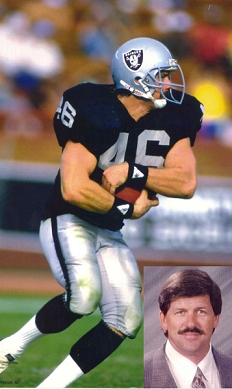 With his eleven-year career in the NFL, Todd Christensen established himself as one of the most prolific tight ends in league history. At 6-3, 230 pounds, he was known as a sure-handed receiver with the ability to get open and make catches in heavy traffic. The Oregon Native first starred at Eugene’s Sheldon High School where he made the All-State team as both a running back and a defensive Lineman. Christensen then went to Brigham Young University where he was a four-year starter at running back. But playing in the wide-open BYU offense, it was as a receiver where he made his mark. Christensen led the Cougars in receiving fro three straight years and helped the team win their league championship in three of his four hyears at the school. He also was the Most Valuable Player of the 1977 Blue-Gray Classic catching 10 passes in the college all-star game.
With his eleven-year career in the NFL, Todd Christensen established himself as one of the most prolific tight ends in league history. At 6-3, 230 pounds, he was known as a sure-handed receiver with the ability to get open and make catches in heavy traffic. The Oregon Native first starred at Eugene’s Sheldon High School where he made the All-State team as both a running back and a defensive Lineman. Christensen then went to Brigham Young University where he was a four-year starter at running back. But playing in the wide-open BYU offense, it was as a receiver where he made his mark. Christensen led the Cougars in receiving fro three straight years and helped the team win their league championship in three of his four hyears at the school. He also was the Most Valuable Player of the 1977 Blue-Gray Classic catching 10 passes in the college all-star game.Christensen was chosen by the Dallas Cowboys in the 1978 NFL Draft but was cut before playing a game with the team. He then played one game with the new York Giants before embarking on aj storied ten-year career with the Oakland/Los Angeles Raiders. With the Silver and Black, Christensen was a five-time All-Pro and member of two Super Bowl Champion squads. His greatest years came from 1983-86 when he twice led the NFL in receptions and set a then league record for tight ends of 95 catches in 1986. Called “The Renaissance Man” during his playing days with the Raiders, Christensen has certainly lived up to that billing. After his NFL retirement, Christensen took his talents to the broadcast booth working as an analyst for both college and pro football games. He was an on-field reporter at tow super Bowls and broadcast from the 1992 Summer Olympic Games in Carcelona. A sought-after speaker, he is President of a non-profit organization called Athletes for Youth that provides activities and financial aid to Los Angeles inner-city youth. Christensen is also an accomplished opera singer and has written three books of self-published poetry.
2002
- Gary Zimmerman - Football
-
2002
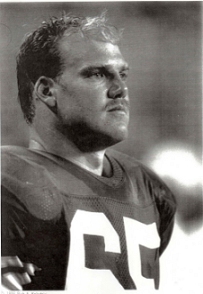 Gary was a three year letterman at Oregon from 1980 to 1983. He is one of the greatest offensive lineman to come out of Oregon. He was named the Pac-10 offensive lineman of the year in 1983 and received the coveted Morris Trophy. Gary was drafted in the first round of the supplemental draft in 1984 by the New York Giants. He played in the USFL for two years for the Los Angeles Express.
Gary was a three year letterman at Oregon from 1980 to 1983. He is one of the greatest offensive lineman to come out of Oregon. He was named the Pac-10 offensive lineman of the year in 1983 and received the coveted Morris Trophy. Gary was drafted in the first round of the supplemental draft in 1984 by the New York Giants. He played in the USFL for two years for the Los Angeles Express. He then entered the NFL with the Minnesota Vikings and finished his twelve year career with the Denver Broncos. Gary was named the NFL lineman of the year in 1997. He was selected to seven pro bowl appearances in his career and was selected All-NFL five times. He was a personal favorite of John Elway and was a key member of the offensive line for the 1998 Super Bowl Champion Denver Broncos.
2003
- Bill Enyart - Football
-
2003
(Apr. 28, 1947 - Feb. 10, 2015) There have been many outstanding football players from Medford but none quite had the flash that carried Bill "Earthquake" Enyart to the top at Oregon State. A standout prep athlete at Medford High School, before the school split North and South, the "Black Tornado" compiled a 26-3-1 record during his three varsity seasons. He was only a sophomore when Medford won the Class 4A state championship in 1962.
Enyart enrolled at Oregon State where he earned his first team All-Conference and Academic All-American honors as a fullback in 1967 and 1968. He earned All-American and All-Coast honors in 1968 while setting a single season rushing record of 1,304 yards rushing, 17 touchdowns, and 102 points. Bill earned three varsity letters as the Beavers went 21-8-1 from 1966-1968; 7-3 in 1966; 7-2-1 in '67; and 7-3 in '68. Against Utah at Salt Lake City, the 6'3" 236 pound fullback carried the ball an amazing 50 times for 299 yards and 3 touchdowns, a mark that stood for 31 years. Both of his records, for carries and yards, remain high in the record books. He went on to rush for a single season school record (at the time) of 1,309 yards and 17 touchdowns.
Following Enyart's senior year, he was selected for five post-season All-Star games: East-West Shrine Game, Senior Bowl, Coaches All-America Bowl, College All-Star Game, and Hula Bowl, where he was named the outstanding back.
Bill ranks fourth in career rushing at OSU (2,155 yards), fifth in scoring (150 points), and second in rushing touchdowns (25). In 1991, he was inducted into the OSU Hall of Fame. Selected by the Buffalo Bills in the second round of the 1969 draft, he played two seasons. He was then traded to Oakland where he played one game before his professional career was ended with an injury. Enyart, who works as a Medicaid care provider in Bend, Oregon, says, "The best thing about football is the friends you make along the way."
2004
- Chris Miller - Football
-
2004
 Chris Miller played at Sheldon High School before lettering four years at quarterback for the University of Oregon. He was a first-round pick in the 1987 NFL draft, taken 13th overall by the Atlanta Falcons. By 1989, at the age of 24, Miller had thrown for more NFL yards than Joe Montana, John Elway, Boomer Esiason or Jim McMahon at the same age. A versatile athlete, Miller also kicked a 25-yard field goal in a game against the San Francisco 49ers.
Chris Miller played at Sheldon High School before lettering four years at quarterback for the University of Oregon. He was a first-round pick in the 1987 NFL draft, taken 13th overall by the Atlanta Falcons. By 1989, at the age of 24, Miller had thrown for more NFL yards than Joe Montana, John Elway, Boomer Esiason or Jim McMahon at the same age. A versatile athlete, Miller also kicked a 25-yard field goal in a game against the San Francisco 49ers. In 1991, he earned a spot in the Pro Bowl by throwing for 26 touchdowns and 3,103 yards and leading NFL quarterbacks with 7.2 yards per rush. He played 10 seasons in the NFL (Atlanta 1987-93; Los Angeles and St. Louis Rams 1994-95; Denver, 1999). He finished his career with 19,320 yards passing and 123 touchdown passes, completing more than 54 percent.
2007
- Jim Shanley - Football
-
2007
A full 50 years after playing halfback for the Oregon Ducks, All Pacific Coast Conference, All-Coast, and All-American Jim Shanley still ranks among Oregon’s top ten performers in nine separate categories.
He was named to PCC all conference teams in 1955, ’56 and ’57. Jim was named to several 1st, 2nd, and 3rd team All-American squads in 1957. He was co-captain during the Rose Bowl season. He was elected a member of the U of O’s all-time all-star team in 1992. During his three varsity seasons, Shanley played virtually every play, and at the same time was an outstanding defensive back. He is also an elected member of the University of Oregon Sports Hall of Fame.
Before becoming a life insurance executive, Jim returned punts for the Green Bay Packers in the NFL. He also was an assistant coach and recruiting coordinator on Jim Sweeney’s staff at WSU. Shanley has been recognized by the University of Oregon President’s Associates for his generous financial contributions.
Jim Shanley came to the Ducks from North Bend High School, where he starred not only in football, but also as an outstanding basketball player and an oft winning track and field sprinter for three seasons. He was an All-State halfback, both his junior and senior years at North Bend, scoring 24 touchdowns his junior year and 15 his senior year, even while slowed with a broken ankle his final three games.
2008
- Jack "Mad Dog" O'Billovich - Football
-
2008
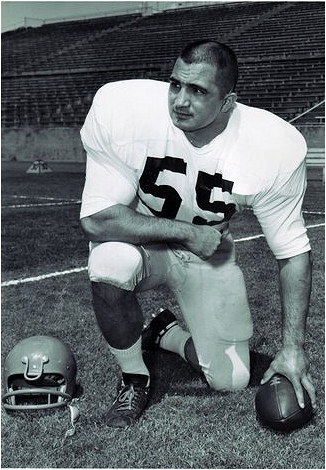 Oregon State football head coach Mike Riley likes to bill the Beavers as “linebacker U” west coast and for good reason. Many recent Beavers have earned postseason honors and went on to the NFL. The lineage of linebackers that OSU has produced can be traced back decades and includes Jack “Mad Dog” O’Billovich in the mid-1960s. O’Billovich earned All-America honors as a junior and helped the Beavers play in the 1965 Rose Bowl. His honors also include All-Pac-8 Conference, All-Coast and team captain. His photo was the cover shot for the NCAA Official Collegiate Football Record Book 1965, with only one football player in the country being chosen for the honor. He concluded his collegiate career as one of a few Beavers to play in both the Hula Bowl and East-West Shrine Game. Jack was a 1966 OSU graduate in Forestry.
Oregon State football head coach Mike Riley likes to bill the Beavers as “linebacker U” west coast and for good reason. Many recent Beavers have earned postseason honors and went on to the NFL. The lineage of linebackers that OSU has produced can be traced back decades and includes Jack “Mad Dog” O’Billovich in the mid-1960s. O’Billovich earned All-America honors as a junior and helped the Beavers play in the 1965 Rose Bowl. His honors also include All-Pac-8 Conference, All-Coast and team captain. His photo was the cover shot for the NCAA Official Collegiate Football Record Book 1965, with only one football player in the country being chosen for the honor. He concluded his collegiate career as one of a few Beavers to play in both the Hula Bowl and East-West Shrine Game. Jack was a 1966 OSU graduate in Forestry.
In 1964 he led the team, coached by the late Tommy Prothro, finished eighth-ranked in the country and ended the regular season beating top-20 Oregon in Eugene. “He was the toughest football player I have ever coached,” Prothro would later say. “He was a very loyal Oregon Stater, but he was a fine human being to start with.” His performance and passion on game day were mirrored in his training and practice during the week and in the off-season. Strength and Health magazine, February 1966, featured Jack in a story about his weight training program at OSU and his disciplined and healthy approach.Following OSU, O’Billovich was drafted by the Detroit Lions where he played the first season, then played in 1967 with the Hamilton TigerCats of the Canadian Football League. The Butte, Montana, native was one of the first individuals to be inducted into the Oregon State University Sports Hall of Fame (1991).
Tony O’Billovich followed his dad’s footsteps to Oregon State, where he was an outstanding linebacker in the early 1990s. Tony was the team’s MVP and co-captain in 1993, and later played with the Toronto Argonauts in the Canadian Football League. Jack’s ashes were dispersed over the Tommy Prothro Football Complex (practice fields) “where he was most at home.”
2009
- Peter Brock - Football
-
2009
The Brock brothers, Peter and Stan from Vernonia, were just two of four football players in the family. Born four years apart, they would follow very similar paths to long and successful grid iron careers.
Both starred at Jesuit High School; both played collegiately at Colorado; both were the 12th overall selection of their respective NFL drafts and both played in the Super Bowl.
Pete came first, a high school and college All-American as a center, he was named to Colorado’s team of the century. He played his entire 12-year NFL career for the New England Patriots.
He proved to be one of the more versatile linemen ever to play the game, filling in as a guard, tackle, wing back, as well as long snapper. He played four different positions in one series of a game and made one career catch for a touchdown. Pete Brock lasted a dozen years in the league despite a series of knee injuries.
The Brock brothers shared one more experience following their careers, both have served as NFL broadcasters.
- Stan Brock - Football
-
2009
The Brock brothers, Peter and Stan from Vernonia, were just two of four football players in the family. Born four years apart, they would follow very similar paths to long and successful grid iron careers.
Both starred at Jesuit High School; both played collegiately at Colorado; both were the 12th overall selection of their respective NFL drafts and both played in the Super Bowl.
Little brother Stan would be known for his longevity. Stan Brock won renown as a tackle for the Colorado Buffs. Coach Chuck Fairbanks called him the best pass blocker in the college game.
Stan spent 16 years as a pro, the first 12 with the team that drafted him in 1980, the New Orleans Saints. He made 67 consecutive starts at one point in his Saints tenure then got his chance at a world championship finishing his career in San Diego.
Stan Brock made a second career as a coach, first in Arena Football, then as an assistant and head coach of the U.S. Military Academy at West Point.
The Brock brothers shared one more experience following their careers, both have served as NFL broadcasters.
2010
- Paul Brothers - Football
-
2010
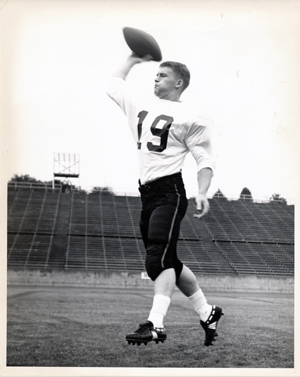 Paul Brothers is one of the state’s most decorated citizens athletically having won a high school state title as a player, led Oregon State to the Rose Bowl, played professionally and then coached a team to a prep state title.
Paul Brothers is one of the state’s most decorated citizens athletically having won a high school state title as a player, led Oregon State to the Rose Bowl, played professionally and then coached a team to a prep state title.Brothers grew up in Roseburg and led the Indians to the state football title in 1961. Upon moving to Oregon State, he quarterbacked the football team from 1964-66, taking over as a sophomore following a season-opening loss to Northwestern. He guided the team to eight wins in its next nine games and a spot in the Rose Bowl, where the Beavers lost to Michigan to finish 8-3.
Following a 5-5 season and 7-3 season, Brothers was drafted by the Dallas Cowboys, but played professionally in the Canadian Football League with British Columbia and Ottawa for three seasons.
Brothers coached prep sports in Eugene at both Marist High and Willamette, which won the state girls basketball title in 2007 and ’09.
He was inducted to the Oregon Sports Hall of Fame in 2010.
2012
- Joey Harrington - Football
-
2012
 A true hometown hero, Joey Harrington has been front and center in the Oregon sports world for nearly two decades and always proud to call Portland home.
A true hometown hero, Joey Harrington has been front and center in the Oregon sports world for nearly two decades and always proud to call Portland home. It was meant to be. The son and grandson of former collegiate quarterbacks, Harrington would blossom as a signal-caller at Central Catholic High School.
4,000 yards and 50 touchdowns later, Joey would follow in his father’s footsteps to the University of Oregon. His timing was perfect.
Harrington was the unquestioned leader during the beginning of the golden age of Ducks football. He led Oregon to 25 wins in three seasons, including bowl victories against Texas and Colorado. Harrington’s 7,000-plus total yards still ranks him as one of the top offensive producers in school history.
The rest of America got to know him as Joey Heisman in the fall of 2001 when a unique Heisman trophy marketing campaign landed his likeness on a giant billboard in Times Square.
Harrington was 4th in Heisman balloting but also took home plenty of honors including 1st team All-America and PAC-10 offensive player of the year.
All of that attention put Joey in the express lane to the NFL. The 3rd overall pick in the 2002 draft, Harrington was elevated to starter in his rookie year. Harrington would play 6 pro seasons, starting a total of 76 games for the Lions, Dolphins, Falcons and Saints.
Even after football, Joey Harrington remains in the public eye as a talented broadcast commentator and a dedicated philanthropist. The Harrington Family foundation supports youth activities and education.
A talented musician, dedicated father and always positive, Joey Harrington is the essence of the favorite son in the Rose City.
2013
- Ken Simonton - Football
-
2013
A California native and all-everything high school football (and baseball) player, Ken Simonton went on to build a new home in the Oregon State Football record books.
Most notably known for his winning touchdown in the 1998 double-overtime Civil War as a red-shirt freshman, Simonton helped the Beavers rise in what is now considered a turning point for the school’s football program.
His record-setting stats speak for themselves. He rushed for more than 5,000 career yards (second most in Pac-12 history), racked up 59 career touchdowns (four of which contribute to Reser Stadium’s record for most rushing touchdowns in a game), and established a new record by rushing for 100 yards in five consecutive games.
After leading the Beavers to a 2001 Fiesta Bowl title over Notre Dame, Simonton was greeted with All-American status and a spot on the Heisman ballot.
His collegiate success led him to a professional career with the NFL’s San Francisco 49ers & Buffalo Bills, the CFL’s Calgary Stampeders, and the Scottish Claymores of the NFL Europe, where he became Offensive Player of the Year in 2003.
Today, Ken lives with his wife, Kollete, and their two children in California, where he is coaching the running backs at his high school alma mater and helping them reach their own dreams of success.
2016
- Mike Hass - Football
-
2016
There was a time a football coach who shall not be named told a young Mike Hass he would not be a successful player.
That was a severe misjudgment. The quiet man with the soft hands from Wilsonville would go from high school legend to Beaver fan favorite, setting his share of records along the way.
At Jesuit High School, Hass was a double threat on offense and defense with an uncanny nose for the football. In Mike’s senior season, the Crusaders won the state championship with one of the most dynamic lineups in Oregon history.
Mike Hass was an almost unstoppable force on offense, catching 79 passes for 1,739 yards and 21 touchdowns. He was named state offensive player of the year and first team all-state and metro league on both sides of the ball.
The Crusaders quarterfinal game against Central Catholic was the seminal moment of that season. The two rivals were ranked co-number one in the state. The game was played the day after Thanksgiving in a thick fog at Hillsboro Stadium. Hass was unstoppable. He scored 7 touchdowns, 6 on offense, 1 on defense. The much-hyped showdown ended in a 55-20 rout.
Two weeks later, Hass would return another interception for a score, clinching a 38-28 win over North Medford in the championship game.
Despite all his prep accomplishments, Mike Hass was not offered a major college scholarship. Another misjudgment. Hass walked on at Oregon State and won a scholarship based on special teams play. That led to three straight 1,000 yard seasons as a starting receiver. That was a first for any PAC10 receiver.
Mike’s senior season was brilliant: 90 catches 1532 yards and 6 TD. He was named to three All-America teams and won the Biletnikoff Award, given to the best receiver in the nation. The award’s namesake, Fred Biletnikoff shared Hass’ best attributes as a heady, sure handed pass catcher.
In just three seasons, Mike Hass set the Oregon State record for career receiving yards with 3,924. His 293-yard game vs Boise State set the conference record for a single game.
It’s a pretty simple story. If you throw a football anywhere near him, Mike Hass will catch it. Whether or not anyone thinks so.
2018
- Steven Jackson - Football
-
2018
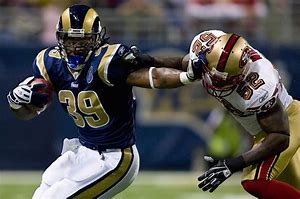
The right man at the right time. Steven “Action” Jackson, the son of a Las Vegas pit boss was destined for bigger things away from the bright lights.
At a time when top Southern Nevada talent gravitated to Southern California, Steven chose to join Dennis Erickson’s high-flying Oregon State Beavers, coming off their best season in school history.
Jackson’s combination of power and speed complimented the quickness of senior Ken Simonton, already a Beaver legend.
In 2002, Jackson became a one-man rushing game paired with the high-volume passing of Derek Anderson. Both were bound for the National Football League.
In Jackson, the Beavers had a durable running back with excellent hands averaging 5 yards every time he touched the ball during his 3-year OSU career.
And he touched the ball a lot! 743 rushing attempts, 66 receptions, 45 touchdowns, a total of 4,545 all-purpose yards. That’s all in three years.
The NFL came calling after Jackson’s junior year, the Rams made him the 24th overall pick in 2004 with their first-round selection.
Just like Corvallis, St. Louis was a perfect fit. Three Pro Bowl appearances in 9 seasons with the Rams and two second team All-Pro selections. 8 consecutive years 1,000 yards rushing.
By the time his career ended with 3 seasons in Atlanta and New England, Jackson had compiled over 11,000 rush yards and had cracked the top 20 list of NFL all-time ball carriers.
Durable, dependable, the right man at the right time. It is now time to welcome Steven Jackson to the Oregon Sports Hall of Fame.